
Student Guide
A 40-Page Introduction to Cornell




So, you’re a smart kid. Congratulations. But not even you can spend all of your evenings in the library cramming for exams and dreaming of your future Ph.D. From local concerts to groundbreaking interviews with Hollywood icons, Arts and Culture is your ticket to college life the way it should be: Worry
free. The Sun is always front row center with the headliners and coverage of arts exhibitions in Ithaca.

This issue brings you some of the best arts stories of the semes ter, plus a spotlight of notable Cornell alumni writers, musi cians and visual artists. 18-19
The Sun’s editors and reporters bring you a guide to life on the Hill. Inside you’ll find information on housing, student activities and orientation. You’ll also find a full-color campus map.
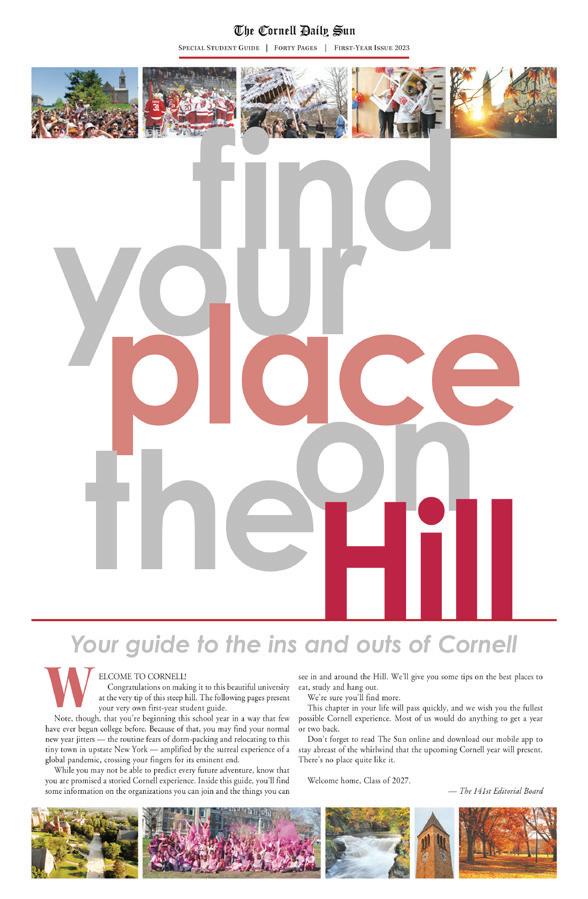
What is the Ivy League? Nothing the name of that school near Boston? Sun.
Editor in Chief: Angela Bunay ’24
Managing Editor: Sofia Rubinson ’24
News: Julia Senzon ’26 Eric Reilly ’25 Jonathan Mong ’25
Photo Editor: Julia Nagel ’24
Main Cover Design: Isabelle Jung ’26
Cover Photos: Sun Photography Staff
About the Cover:
The cover has an array of iconic Cornell moments and events, including photos from the slope, the Cornell Fashion Show, the chimes, hockey team wins and A.D. White in the winter all tacked onto a cork board of Cornell memories.
POSTAL INFORMATION
The Cornell Daily Sun (USPS 132680 ISSN 10958169) is published by the Cornell Daily Sun, a New York corporation, 139 W. State St., Ithaca, N.Y. 14850. The Sun is published Monday, Tuesday and Thursday during the academic year, and every weekday online. Four special issues — one for Cornell Days in April, one for seniors in May, one for alumni in June and one for incoming freshmen in July — make for a total of 89 issues per year. Subscriptions are: $84.00 for fall term, $86.00 for spring term and $170.00 for both terms if paid in advance. Standard postage paid at Ithaca, New York.
Postmaster: Send address changes to The Cornell Daily Sun, 139 W. State St., Ithaca, N.Y. 14850.
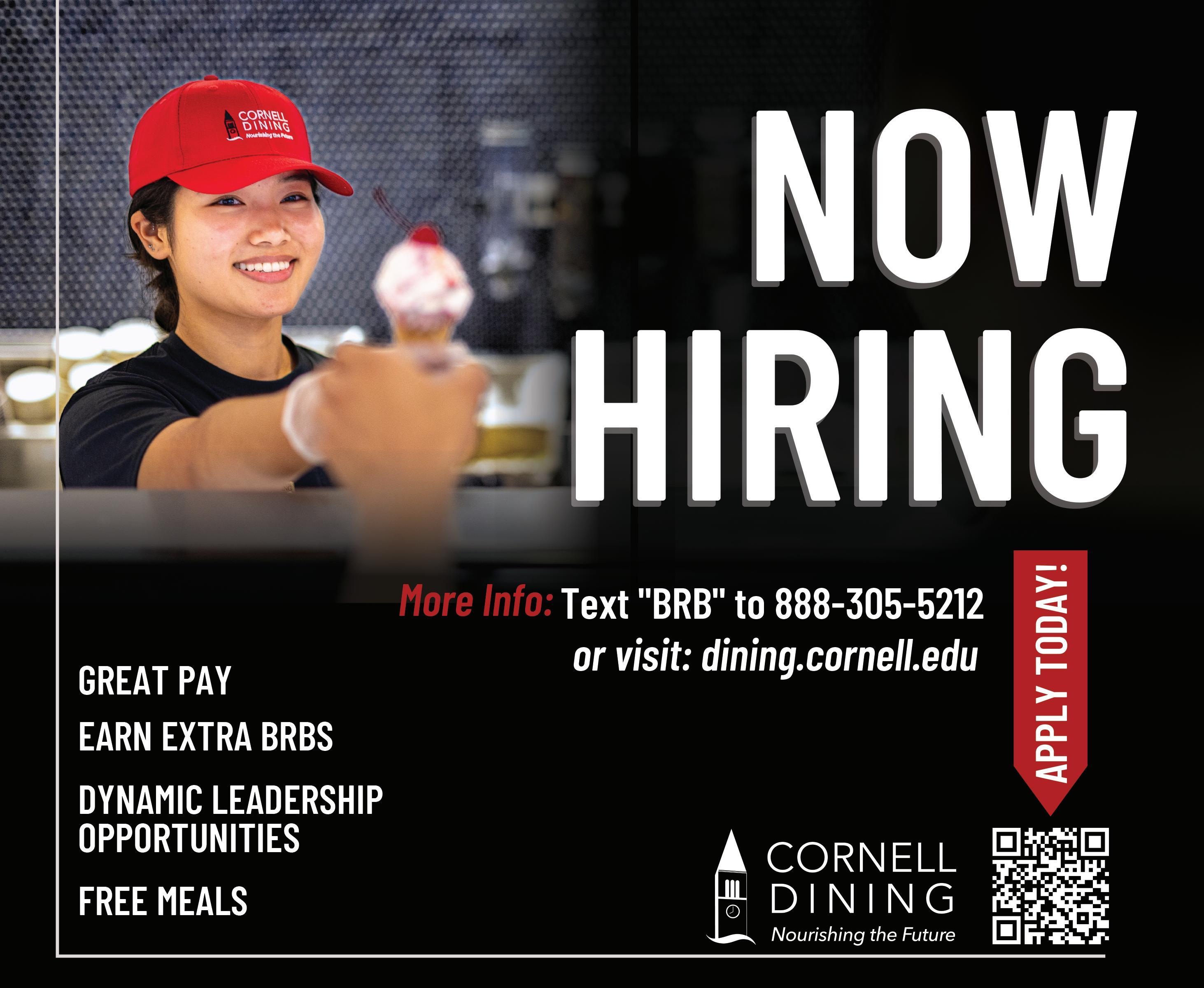
Cornell has no journalism major — and we wouldn’t have it any other way. Here at The Sun, we subscribe to the philosophy that one learns best by doing. So it’s no surprise that at the nation’s oldest continuously independent college daily, we think of ourselves as the University’s journalism education. When you arrive on campus about a month from now, The Sun will also serve as your window to the world from our little corner of Ithaca, N.Y.
Every day during the academic year, about 15,000 students, parents, alumni, administrators and local residents read the print edition of The Sun; another 15,000 people visit cornellsun.com daily. And in 2015, The Sun was ranked the number one college newspaper in the United States by The Princeton Review.
The Sun was founded in 1880. Since then, we’ve built up an impressive record of hard-hitting journalism and community service, and we have given generations of Cornellians something better to pay attention to in their 10:10 a.m. classes.
We’ve also delivered the skills it takes to succeed to a lengthy roster of Amer ica’s top writers and business people, jumpstarting the careers of Sun graduates E.B. White 1921, Kurt Vonnegut ’44, Dick Schaap ’55, Oscar Mayer ’34 and Frank Gannett 1898. More recently, The Sun has been home to Pulitzer Prize winners John Hassell ’91 of the Star Ledger of Newark and Molly O’Toole ’09 of The Los Angeles Times. ESPN’s Jeremy Schaap ’91 was a Sun sports editor and NPR’s David Folkenflik ’91 was editor in chief. Former Editor in Chief Andrew Morse ’96 currently serves as president and publisher of The Atlanta Journal-Constitution and former Managing Editor Jeff Stein ’13 founded The Ithaca Voice and is currently the White House economics reporter at The Washington Post. Former Editor in Chief Marc Lacey ’87 is now the managing editor of The New York Times.
If you want to become a part of this exciting tradition — and help write the next chapter of The Sun’s history — just show up. We’ll give you the skills you need for a career in news, sports and commentary.
Once you get to campus, you’ll see The Sun Tuesday and Thursday mornings in dorms, dining halls and countless other locations — and every day online. But few realize what it actually means to “put out the paper.” Cornell’s only daily stu-
dent-run newspaper is a multi-faceted organization that only works because of its members.


Editors spend what some might consider way too much time with one another, working on The Sun. But all agree on the irreplaceable role the paper has taken in their lives.
The News section — the paper’s largest — tracks and reports all campus life events and local and national issues relevant to you. Every day, the staff is talking to people around campus and conducting interviews in preparation for stories.
Where there’s news, The Sun is there covering it. From covering the ongoing Starbucks unionization conflicts and contentious Student Assembly resolutions to exclusive interviews with President Martha Pollack, the News section has full access.
The Sports section works hard each day to keep Cornell abreast of the newest developments of the sporting world both inside and outside Big Red nation. With game recaps, athlete profiles and commentary on everything, you will always find action on the back page. And don’t forget to look for the seasonal pullouts for an in-depth look at Cornell’s athletics.
The Arts and Culture section is The Sun’s cool crew.
From movie reviews to exhibits at the Johnson Museum to local bands, Arts gives us the backstage pass to all the places to be and be seen.
Hidden behind the news you will find The Sun’s Opinion and Editorial section, a center of raucous campus debate where columnists and community members sound off about local and national issues alike.
The Science section plays a vital role at Cornell, one of the most profound research institutions in the world. Science reporters stay up to date with cutting-edge findings from Cornell scientists around the world.
The Sun’s Dining department is staffed by the most opinionated foodies on campus, boldly braving the best and worst of the Ithaca dining scene and critiquing the newest eateries both on campus and off. Look out for the Dining Guide every week in Thursday’s paper.
A picture is said to be worth a thousand words, which is why The Sun’s Photo department is so vital to The Sun. Our photographers go to great lengths to ensure that a story is visually represented, even if it means trekking in the rain and snow all over central New York.
Creative and always inquisitive,
There is no regular day at The Sun, but here is what typically goes into producing a daily paper.
Morning: Staffers read The Sun, go to class (maybe), work on that day’s stories. The business office is open from 9 a.m. to 5 p.m.
5 p.m.: Editors arrive at The Sun’s offices at 139 W. State Street, which is a 20-minute walk down the hill from
Central Campus or a five-minute drive or bus ride. They begin to lay out and edit the paper that will appear on newsstands the following day.
7 p.m. - 10 p.m.: Editors, designers and photographers meet to discuss articles and placement of stories in the next morning’s paper. Editors read and edit articles, working with the writers for accuracy and clarity. Editors assign future stories; other editors work on editorials and last-minute stories. Photographers
edit photos. Design staffers work on pages as stories are finalized.
10 p.m. - 11:30 p.m.:
Breaking news stories come in; finishing touches are made to the paper’s content and design.
11:30 p.m.:
The paper goes to bed. Stories, photos and other content are webbed for the online edition. The paper is printed in Towanda, Pennsylvania, and delivered to newsstands across campus.
our Layout and Design department knows style like the back of their hands. When they’re not laying out pages, our designers are helping to create seasonal sports supplements or covers for special issues, like the one you’re reading now. The Sun is much more than a printed paper, though. The Sun strives every day to provide our readers with fresh and engaging content on its website. The Multimedia department works with other departments to produce videos that supplement print
coverage. The creativity that the department puts into filming and editing makes the story truly come to life.

The Web department works behind the scenes to strengthen The Sun’s online presence and is always there to save the day if the website crashes. They develop new elements of the site, keeping The Sun on the cutting edge of digital journalism.
A New York State for-profit corporation run entirely by students, The Sun rises every morning thanks to the Business department. From selling advertisements
to managing a budget, the department keeps The Sun’s brand afloat and gives students the real-world experience of running a business. And in between the blood, sweat and tears that go into daily production, we find the time to have fun and keep you all — our community of readers — curious, connected and better informed.
Look for recruitment details in The Sun during Orientation Week or email Sofia Rubinson ’24 at managing-editor@cornellsun.com.
This story was originally published on March 31.
Members of Cornell’s prospective Class of 2027 breathed a sigh of relief after their college admissions process came to an end, each eager to find their place on the hill this coming fall.
At 7 p.m. on Thursday, March 30, the University, along with each of the seven other Ivy League institutions, released its final round of admissions decisions. Students across the world know this long-standing tradition as “Ivy Day.”
“It was like this, almost sacred, type of thing,” Sam Jacobson ’26 said, recalling his emotions from last year’s Ivy Day. “It’s a lot of suspense, nerves [and] pressure… it’s definitely a hyped-up day for something as mundane as checking a portal, which happens probably in the span of thirty minutes.”
Historically, numerous universities, including the Ivy Leagues, held annual “Ivy Day” ceremonies, which consisted of placing an ivy stone on a university building in honor of academic excellence. At the time, the ceremony was also known as “planting
the ivy.”
Today, Ivy League universities and their students honor this tradition by releasing regular admission decisions simultaneously each year. For current students and prospective applicants of these selective institutions, “Ivy Day” continues to bring waves of anticipation.
Jacobson recalls the day he awaited his own acceptance letter.
“I came home [from school] that day at around 3:30, and [the rest of the day] was literally my family and I sitting around waiting for the clock to turn 7… we were checking every minute,” Jacobson said.
Last year, Cornell welcomed a “talented and diverse” Class of 2026, with students hailing from all 50 states and 85 countries. This year, admitted students again represent every U.S. state including Washington, D.C., Puerto Rico, the U.S. Virgin Islands, Guam and American Samoa. The class additionally constitutes 87 countries.
“Students in the Class of 2027 had some time to adjust to pandemic disruption during high school,” said Jonathan Burdick, vice provost for enrollment. “True to Cornell’s founding vision, these extraordinary students
es in University grant aid for all undergraduates who qualify for financial aid.
will bring a diverse range of ideas and experiences to enrich campus life together.”
For the Class of 2027, 4,994 students were admitted in total, with 3,324 being notified on Ivy Day. An additional 1,670 applicants were admitted during the early-decision round in December.
The Class of 2026, with 71,164 applicants and 5,168 admits, had an all-time low acceptance rate of 7.3 percent. Acceptance rates for the Class of 2027 will not be released until the summer.
Prospective students continue to be drawn to Cornell’s vast number of opportunities. For Lucas Macedo ’27, who is from Brazil, Cornell’s unique agricultural sciences program inspired him to apply to the College of Agriculture and Life Sciences.
“I knew of all the available resources they have for someone who is interested in agriculture and how I would have access to so many opportunities that I would not have in other institutions,” Macedo said.
Reed Robinson ’27, who is from Portland, Maine, intends to major in Environment and Sustainability due to his interest in conservation.
To continue reading this story, please visit cornellsun. com.
This story was originally published on May 8.
The 2022-2023 school year brought both progress and controversy for Cornell, with the creation and continuation of various campus initiatives, disruptions in Greek life and more recently, tense discussions over the state of free speech at the University. Discussing these topics and more, President Martha Pollack sat down with The Sun to review her top priorities and stances on the most contentious issues affecting Cornellians.
Affordability
Cornell’s affordability is a primary concern for many Cornellians, with undergraduate tuition increasing by 4.4 percent going into the 2023-2024 academic year. Pollack commented on the financial resources required to sustain the University.
“To provide the kind of education we want to provide at Cornell, it’s very expensive. We do everything we can to control costs,” Pollack said. “But, world-class faculty are expensive, [as are] world-class labs and facilities [and] world-class libraries — so we need resources.”

Regarding the rise in tuition, Pollack emphasized that Cornell always increases financial aid with tuition. She noted that the University follows a structured budget model to control costs.
“If you look at the amount that students who receive aid pay and adjust for inflation, they actually pay less now than they did 20 years ago,” Pollack said.
The University launched the To Do the Greatest Good initiative in October 2021, which aims to raise $5 billion for the University by 2026. For the Spring 2023 semester, the campaign allowed for increas-
Pollack stated that the initiative is on track to reach its fundraising goals, which include $3 billion to fund the Ithaca campus, $1.5 billion for Weill Cornell Medicine and $500 million for Cornell Tech.
One of the goals of the campaign, Pollack said, is to improve socioeconomic diversity among Cornell’s student body. The University aims to increase the number of students on financial aid, though Pollack noted that the proportion of students on aid will not increase due to a rise in overall enrollment. Approximately half of Cornell undergraduates receive financial aid, Pollack said.
“If you compare to 2020, not only have the number of first-generation students increased from 13 percent to more than 19 percent, but the number of students who are coming with aid has increased by about 650 [students],” Pollack said.
Cornell’s endowment reported a 1.3 percent investment loss for the 2022 fiscal year, compared to a significant 41.9 percent gain during the year prior.
To maintain stability in the funds directed to the University, Pollack said the value of the endowment is averaged over a certain period, and the amount paid out in a year is based on this average. Pollack added that, when she came to Cornell, she expanded this period to seven years.
“What that does is it smooths the amount of money we have. So, when things go bad, we’re still averaging in those good years,” Pollack said. “When things get good again, you’re still averaging in from the bad years, but it protects you against drops in the future.”
To continue reading this story, please visit cornellsun.com.
APRIL 2022
Ithaca First City to Unionize All Starbucks Locations
Following efforts extendin back to October 2021, all three Ithaca Starbucks locations voted to unionize on April 8, 2022. The outcomes of the votes for the College Avenue location, the Ithaca Commons location and the Meadow Street location were 19-1, 15-1 and 13-1, respectively.
“A lot of my coworkers are very happy, but we know this is only the first step in the next chapter of our journey,” said Evan Sunshine ’24, a barista and member of the union campaign’s organizing committee. “We’ll have to do bargaining with Starbucks for our first contract and only then we’ll be able to reap the benefits of the union.”
Starbucks to Close All Ithaca Locations by May 26, 2023
A year after the Starbucks workers in Ithaca successfully voted to unionize, Starbucks has announced that it will permanently close the two remaining Ithaca locations — on E. Seneca Street and S. Meadow Street — by May 26, 2023, although it denied that the closures were in retaliation for the unionization effort.
Starbucks employee Evan Sunshine ’24 stated that Starbucks’ justification to the workers for closing the stores was due to financial and operational needs, although he expressed skepticism about the reasoning. Starbucks Corporate did not respond to The Sun’s request for comment.
MAY 2023
MAY 2023
Students Occupy Day Hall Over Cornell’s Starbucks Partnership
Student organizers and Starbucks employees occupied Day Hall on May 11, 2023, to urge Cornell to end its partnership with Starbucks.
On both North and Central Campuses, most Cornell dining halls and cafes serve Starbucks brand beverages. Rally organizers primarily demanded that the University publicize its contract with Starbucks and sever its relationship with the corporation, switching providers for all on-campus dining establishments that serve Starbucks products.
Organizers require a campus-wide switch to an “ethical” brand that is approved by the student activists occupying Day Hall and Starbucks Workers United before the fall semester.


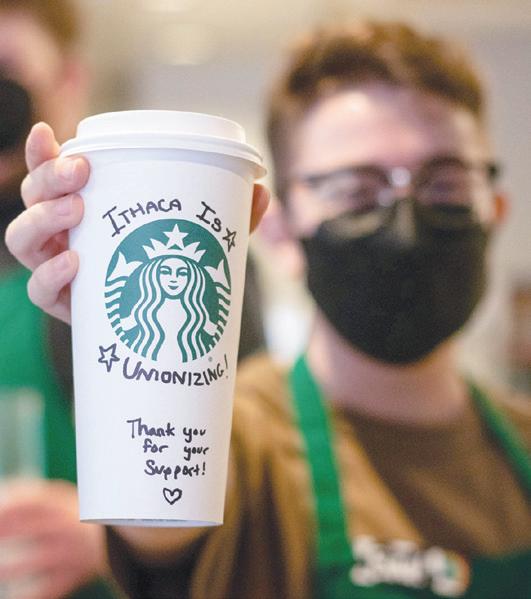
Starbucks Corporate announced the closure of the recently unionized College Avenue location set for June 10, 2022, in a move that workers are calling “union-busting.”
Workers at the store went on strike April 16, 2022, alleging unsafe working conditions due to a hazardous grease trap that had become a longstanding problem.

Starbucks workers voiced that the store closure came as a shock, given the store was a staple to not only Cornell but also Ithaca community members.
“We weren’t surprised that Starbucks would pull something like this because they have been using several underhanded tactics to take advantage of the union and fearmonger to discourage unionization,” said Starbucks employee Evan Sunshine ’24.
JUNE 2022
Downtown Starbucks Workers Strike on Red Cup Day Red Cup Day is one of the busiest days of the year for Starbucks: it is the one day of the year when customers can receive a free, limited-edition reusable cup with the purchase of any holiday or fall beverage. However, Ithacans trying to get their red cup at the Ithaca Commons location this year were met with something else — a Starbucks worker’s strike.
Joining over a hundred stores across the country, the Ithaca Commons Starbucks workers held a day-long strike on Thursday, calling on Starbucks Corporate to come to the bargaining table as national union efforts continue to grow.
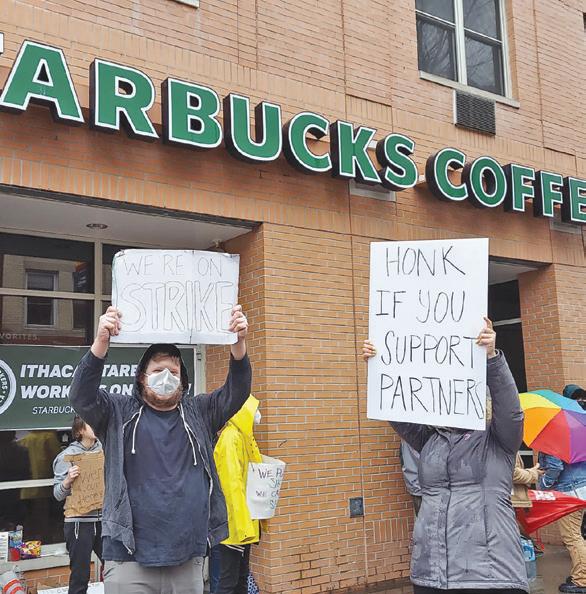
Starbucks Found Guilty of Violating Labor Laws in Collegetown Closure
Starbucks was found guilty of violating U.S. labor laws in its treatment of employees across unionized Ithaca locations and in the permanent closure of Collegetown Starbucks in a National Labor Relations Board ruling on July 6, 2023.
Judge Arthur J. Amchan’s ruling comes after more than a year of local disputes over workers’ conditions.
Amchan wrote in his decision that Starbucks violated the National Labor Relations Act several times by dismissing and punishing employees and by more harshly enforcing company policies after the company knew of unionization efforts in Ithaca stores.
JULY 2023
This article was originally published May 12. Continued from above.
Organizers discussed expanding the number of locations offering Gimme! Coffee — which is currently sold at Bill and Melinda Gates Hall and in three other Ithaca locations. According to Wilson, Gimme! Coffee is ideal due to being a local, unionized worker-run co-op. On Tuesday, organizers offered free Gimme! Coffee in front of Starbucks stores and campus dining establishments selling Starbucks products while discussing their cause and asking for optional donations, which ultimately raised over $700 in support of the strike.
To Wilson, specifically targeting Cornell’s relationship with Starbucks — rather than Starbucks as a whole — is a way to leverage the organizers’ authority as students of the University.
“You can’t negotiate with Starbucks — that’s a boardroom full of multinational executives who won’t listen to us,” Wilson said. “Where power is, is we have this affiliation with the University [as students], and we have the ability to democratically rise up and say, ‘This is what we demand.’”
Wilson noted that organizers believe Starbucks is making a profit of millions of dollars through its relationship with Cornell, but this contract is not currently public. In turn, disrupting the agreement between Cornell and Starbucks is a way for organizers to demonstrate to the corporation that there are economic consequences to what they consider to be a national union-busting campaign.
Prior to the occupation of Day Hall, orga-
nizers urged Cornell students to send over 900 emails to the University demanding that they sever all University ties to Cornell, although Ryan Lombardi, vice president of student and campus life, denied receiving an email until 30 minutes prior to his and Dean of Students Marla Love’s initial arrival in the lobby of Day Hall shortly before 5 p.m., where students had already been gathered for hours.
“The President wants to engage with you in good faith and talk about this,” Lombardi said. “[We] can’t make a commitment today to honor the demands that you’ve brought forward — we just haven’t had time to look at all the ramifications and implications of that. We know that some emails were sent this week. I got my first 30 minutes ago.”
Lombardi then called into question the veracity of some of the emails, saying they were generic and did not appear to come from Cornellians, but Wilson refuted the accusation, saying students had endorsed the sending of each message.
Following this exchange, Lombardi and Wilson began discussing the policy demands made by the demonstrators. Lombardi said President Pollack was out of town and accused the demonstrators of negotiating in bad faith with the administration.
“I’m willing to make that commitment to have this dialogue and try to figure something out — see what we can come up with,” Lombardi said. “But I cannot make this commitment today that you’re asking us to make. And I think it’s unreasonable to ask us to make that on the spot. That’s not giving us a fair chance to really look at all the implications.”
To continue reading this article, please visit www. cornellsun.com.
By JULIA SENZON and GABRIEL MUÑOZ Sun News Editor andThis article was originally published July 7. Continued from above.
He also described that the company showed anti-union bias by cutting operating hours at stores, telling employees that the Collegetown location would permanently close before an official decision was made and failing to negotiate with Starbucks Workers United — the union representing Ithaca’s Starbucks employees.

“Starbucks violates the Act when it prioritizes bringing stores up to standards through employee discipline in response to union organizing,” Amchan wrote. “There is no showing herein that Starbucks would have paid the attention it did to the Ithaca stores and its employees absent its awareness of union organizing.”
Amchan emphasized the wider effect of the treatment of Ithaca employees on Starbucks workers nationwide.
“Given the wide-spread publicity given to union organizing at Starbucks stores and Starbucks’ response, employees at the 9,000+ Starbucks can only assume that they are risking their livelihood by organizing when they learn that Starbucks closed a store like College Avenue and got rid of almost all its employees either before or after the store closed,” Amchan wrote.
As part of his ruling, Amchan required Starbucks to reopen the College Avenue location and reinstate terminated employees with payback. The corporation would also have to remove any reference to the unlawful dismissal and penalties given to eleven former employees from their files.
Starbucks also would be required to agree to bargaining agreements with Starbucks Workers United regarding the Ithaca locations. He also ordered Starbucks to post a notice about working rights in all locations nationwide in addition to distributing the information electronically.
Starbucks told Bloomberg on Thursday that the company intends to appeal the decision.
“Where claims have been filed against Starbucks that we believe are unfounded, we continue to defend the company and the rights of our partners as matters are fully adjudicated by the NLRB and federal courts,” a Starbucks spokesperson said in an email to The Sun. “We strongly disagree with the administrative law judge’s recommendations issued and intend to file exceptions contesting the findings and recommendations made.”
Starbucks’ statement also stated that the company’s policies are set to facilitate a hospitable and safe atmosphere for partners and customers and to outlaw anti-unionization practices. According to the statement, Starbucks established a management training program and instituted a labor relations team in the fall to support the company’s compliance with both company policies and labor laws.
“We respect the right of all partners to make their own decisions about union representation, and we are committed to engaging in good faith collective bargaining for each store where a union has been appropriately certified following a representation election,” the statement said.
To continue reading this article, please visit www. cornellsun.com.

This story was originally published on March 23, 2020.
When Dr. Anthony Fauci did not appear at a White House news conference on March 18, “Where is Dr. Fauci” began trending on Twitter — proving to many that Fauci has become one of the U.S.’s most trusted voices in the fight against the progressing COVID-19 pandemic.
The head of the National Institute of Allergy and Infectious Diseases, member of the White House Coronavirus Task Force and “the most influential man in American public health” is also a Cornell alumnus.
Fauci received his medical degree from Weill Cornell Medicine in 1966, ranking first in his class. Two years after graduation, he began working for the National Institute of Public Health as a clinical associate, and eventually became the director in 1984.
In this role, Fauci was at the forefront of the AIDS epidemic that hit the U.S. in the 1980s. While urging the federal government to increase funding for AIDS research and treatment, Fauci spearheaded the development of combi nation drug treatments — when different types of drugs are prescribed so the virus is less likely to become resistant to all of them simultaneously — that increased the lifespan of HIV-positive individuals. Fauci is currently developing an HIV vaccine to completely eradicate the disease.
During the SARS outbreak in
2003, Fauci and his team began isolating the virus and developing a vaccine. The SARS outbreak was successfully contained within four months. He has also led government efforts to prevent the spread of the 2009 H1N1 pandemic and the Ebola outbreak in 2014.
“Fauci once again is playing an absolutely critical role in the face of an epidemic in this country,” said Chris Schaffer, biomedical engineering. Schaffer worked as a science policy advisor for Sen. Ed Markey (D-Mass.) and now teaches the class Biomedical Engineering 4440 Science Policy.
Since the initial outbreak of COVID-19 in Wuhan, China, Fauci has served as a national expert on combating the disease. Appearing at press conferences alongside President Donald Trump and other White House officials, Fauci doesn’t sugarcoat
“When you’re dealingtious diseases outbreak, you are always behind where you think you are,” Fauci said
Through various media appearances, Fauci’s main role in the outbreak has been educating the public on how the virus spreads and ways to prevent the spread from person to person, as well as being involved in the initial stages of developing a vaccine.
“He’s helped us understand that if we feel like we’re overreacting, that probably means we’re still behind the curve... that’s an excellent way of trying to help someone get their head around the idea of exponential growth,” Schaffer said.
Fauci and the White House Coronavirus Task Force established a set of guidelines on March 16, outlining how Americans can slow the spread of the virus in their communities. These guidelines encourage those that feel ill or have underlying medical problems to stay home and urge the general public to practice social distancing and good hygiene.
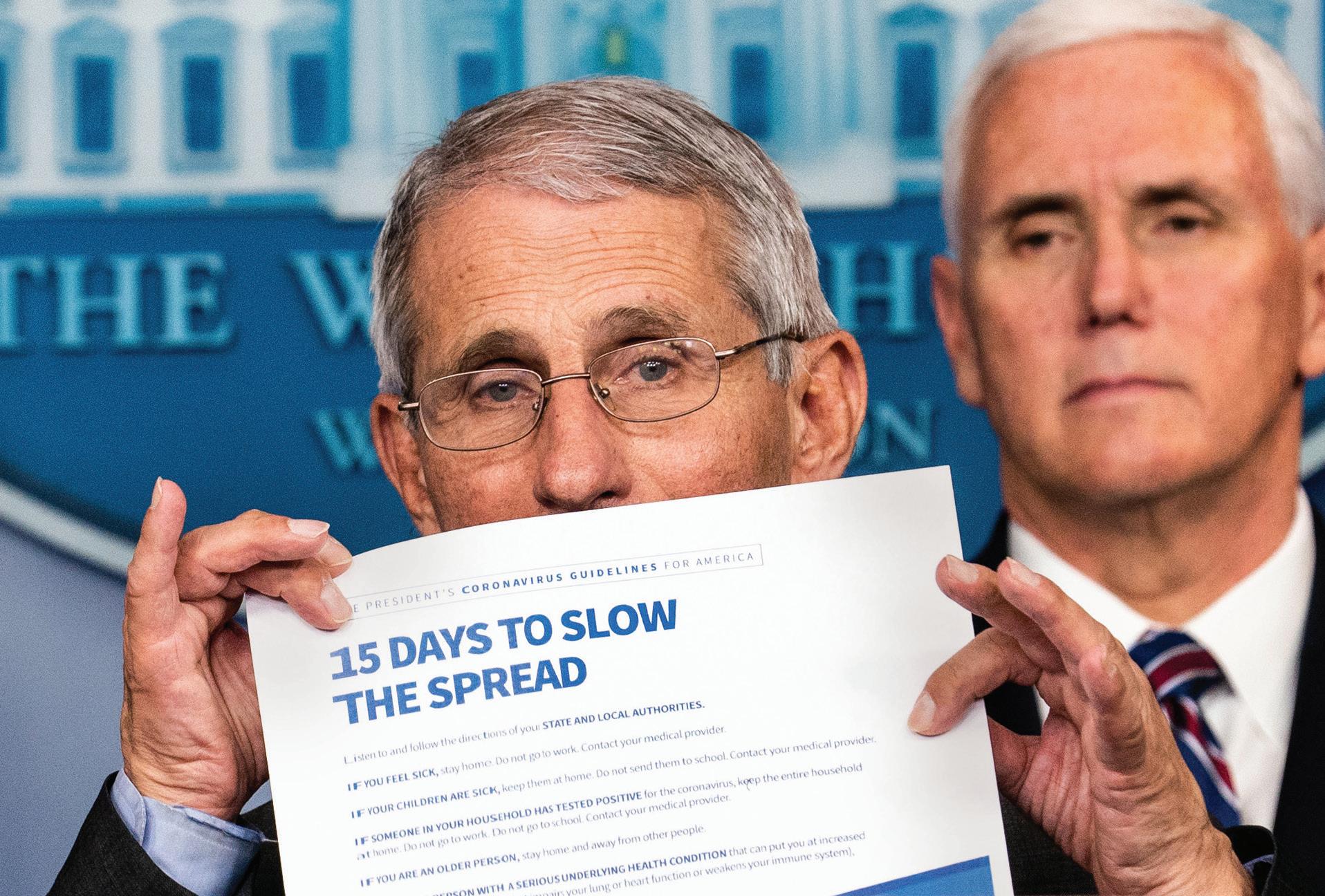
Fauci also garnered media attention for the way he publicly contradicts the president at news conferences about the pandemic.
“He’s negotiated this fine line between being able to consistently and reliably state what he believes the science is telling us we need to do and what we need to prepare for, while at the same time correcting statements that are made within seconds of [the president’s] statements,” Schaffer said. “He’s done it in such a way that he hasn’t pissed the president off.”
The NIAID director has received multiple accolades for his work in public health, including the Presidential Medal of Freedom in 2007 and the Weill Alumni Award of Distinction in 1992.
“He’s fearless, candid, and able to translate what he understands from the science into actions that we should take... he’ll be responsible for saving tens of thousands of lives if not more,” Schaffer said. “I can’t imagine a better person to look to for answers.”
 By ANIL OZA Former Sun Assistant Managing Editor
By ANIL OZA Former Sun Assistant Managing Editor
This story was originally published on April 30, 2020.
While Dr. Anthony Fauci MD ’66 leads the national response to the COVID-19 pandemic, another Cornell alumni, Melissa DeRosa ’04 MPA ’09, is spearheading New York’s response to the outbreak.
Throughout the past several weeks, a common sight on the televisions of most New Yorkers has been Gov. Andrew Cuomo’s (D-N.Y.) providing updates on the extent of the statewide outbreak and any policy changes during his daily briefings. Sitting six feet to Cuomo’s left at all of these briefings is DeRosa.
Currently, DeRosa serves as the secretary to the governor. However, this role is not merely an administrative role. The secretary is a top aide to the governor, and is the most powerful unelected position in state government. At 34 years old, DeRosa is the youngest person to occupy the position in New York, and is the only woman to do so.

DeRosa’s involvement in state politics began at an early age, when she helped her father campaign for former Rep. Louise Slaughter (D-N.Y.) in Albany. DeRosa continued to be involved with politics through her father, who worked as a lobbyist in Albany. She eventually found her way to Cornell, where she pursued a degree in public
administration in the School of Industrial and Labor Relations, according to Cornell Alumni Magazine.
During her time as an undergraduate, DeRosa spent a summer in Washington D.C., working in the office of former Sen. Hillary Clinton (D-N.Y.). DeRosa continued her education at Cornell, earning a master’s degree from the Institute for Public Affairs with a focus in government, politics and policy. While in graduate school, DeRosa was a member of Pi Alpha Alpha, the global honor society of public affairs and administration.
As secretary to the governor, DeRosa is responsible for managing the governor’s responsibilities as well as meeting with local legislators, officials, policy advisers and other experts to brief the governor. During her time in Cuomo’s office, she has been instrumental in pushing forward the $15 minimum wage and paid family leave policies.
The tall task of managing the U.S.’s fourth most populous state has grown exponentially in the past weeks as the number of confirmed COVID-19 cases in New York State has skyrocketed and the state has become a global epicenter of the outbreak. As of Wednesday night, New York has over 300,000 confirmed COVID-19 cases.
“We’ve dealt with snow storms, flooding, and hurricanes in New York, but those were all static events,” DeRosa said in an interview with ELLE. “This is the first situation the world has had to endure that is as ongoing, and as constant for an indefinite period of time as the
Throughout the ever changing circumstances, Cuomo and DeRosa have aimed for maximum transpar ency, keeping the public updated with their daily television briefings. To keep up with the rapidly evolv ing situation, DeRosa starts her mornings at 3:45 a.m., deciphering the various reports that detail the latest updates before reporting to Cuomo to work on the talking points for the day’s briefing.
DeRosa has specifically managed the state’s dealing with restaurant closures and voting via absentee bal lot. The young aide is currently lead ing the governor’s communication strategy on the state’s response to the virus.
Most recently, DeRosa has led the state’s Maternity Task Force and provided rec ommendations for serving pregnant women across the state during the pandemic. Cuomo took up the recommendations and issued an executive order on April 29, opening more birthing sites to provide patients more options for delivery locations, prolonging the amount of time a partner can accompany the mother post-delivery and establishing doulas as essential support during labor.
Before taking up the role of secretary to the governor, DeRosa worked in several positions in Cuomo’s office. She joined the team in 2013, as the communications director and strategic adviser. She held this position for two
for New York State Attorney General Eric T. Schneiderman and former President Barack Obama’s political action organization, “Organizing for America” before joining Cuomo’s office.
“This crisis is a challenge on a scale unseen before and it tests us on every level: public health, economic stability and our basic human nature,” Cuomo said in an email to ELLE. “I need the best minds to meet the challenge and Melissa is invaluable not just to me — as a counsel, strategist, sounding board, and policy maker — but equally to the State and the entire team she leads.”
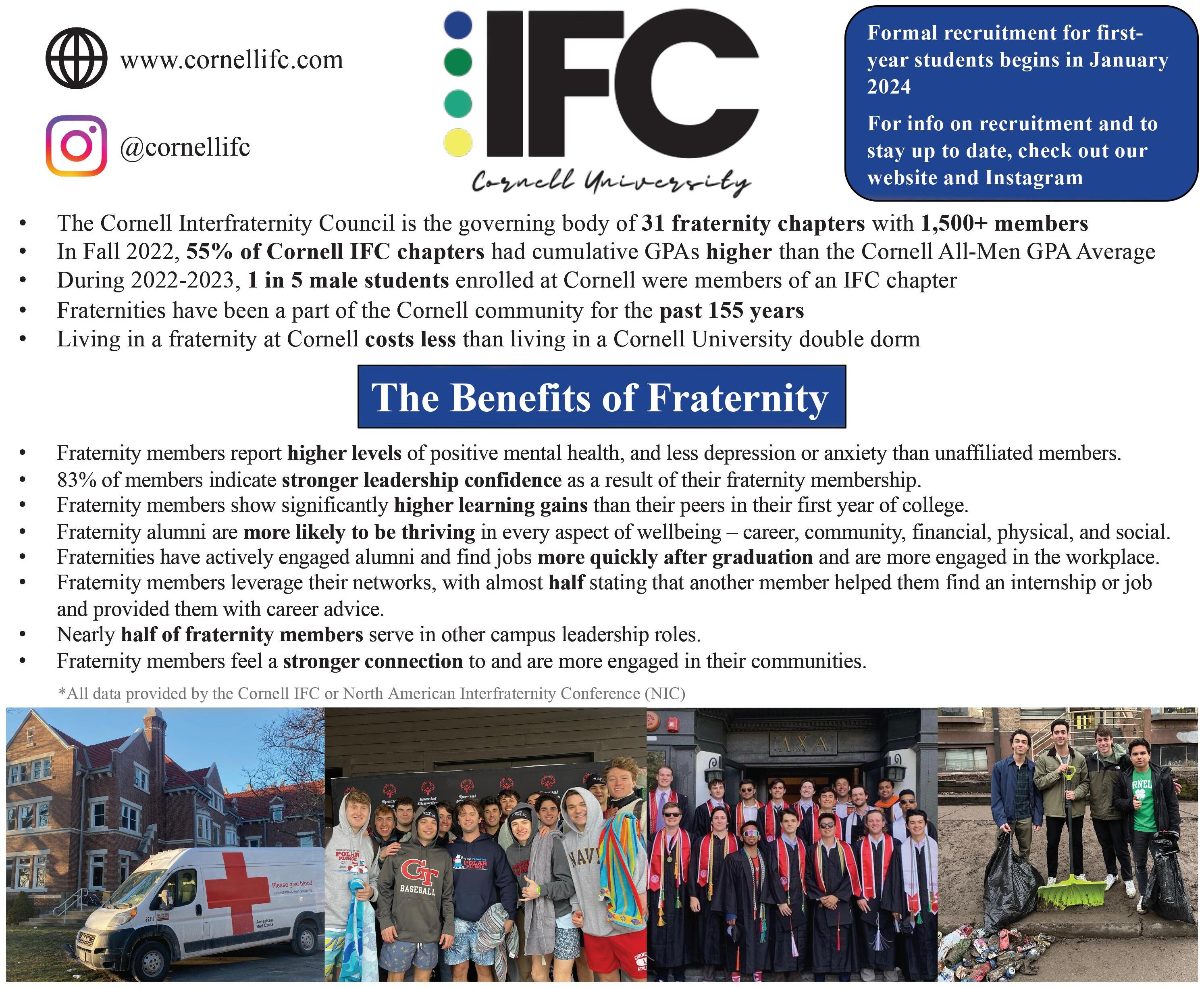
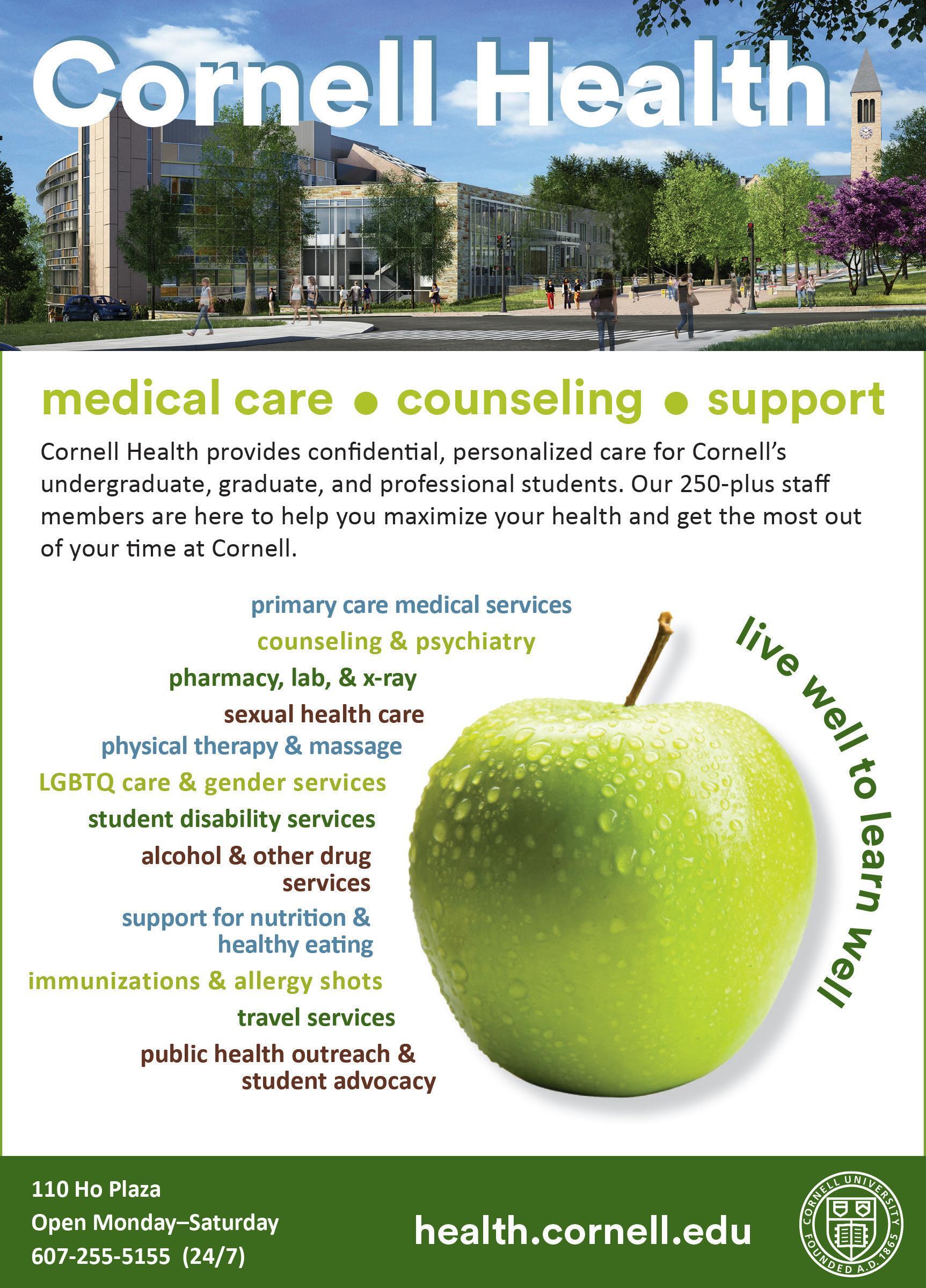

This story was originally published on Nov. 6, 2018.
For four years in a row, Cornell’s undergraduate acceptance rate has sloped downward while the number of applicants annually grows by the thousands.
Most tellingly, in 2012, 16.2 percent of applicants were selected for the Class of 2016. This May, for the Class of 2022, that number was 10.3 percent.
As students scramble for a spot in the Class of 2023, The Sun sat down with two admissions officers in charge of the process — Jason C. Locke, interim vice provost for enrollment, and Pamela Tan ’97, director of admissions of the College of Agriculture and Life Sciences — to delve into how Cornell evaluates and selects its students.
What Cornell Seeks in a Student
Locke admitted during the interview that admissions is a “highly difficult process and very subjective,” acknowledging that it is a multi-step process where multiple individuals evaluate each applicant.
Unlike many other colleges, which review all applications from a central undergraduate admissions office, Cornell has a “somewhat unique system,” according to Locke. Once an application is submitted, it will be given to the one — and only — college or school that the student is applying to, where his or her material will undergo what Locke called a “first review.”
About 80 percent, or over 40,000 of the applicants, will be chosen to proceed to the next step. Only after the applicant has successfully passed the academic review, the admissions staff will consider other components of his or her application — such as recommendation letters and extracurricular activities, Tan said.
In the first review, the admissions staff of each college acts as gatekeepers by looking at the applicants’ academic performances to determine whether the student will do well at Cornell. This assessment relies on all scores and grades submitted by the students, but will place the heaviest weight on their high school records.
Those who make it to the next step are not the ones “that have E’s and F’s on their transcript,” Tan said. “Even if you are an outstanding student who’s a great fit for Cornell and have wonderful extracurricular activities … there’s not much I can say about you.”
However, grades are not the only thing that the admissions officers value on transcripts. In addition to the level of performance, Locke said Cornell also looks at how demanding those courses are. In colleges like CALS, where students must pick a major or at least specify a general subject in their applications, admission officers will also take into consideration whether the students have taken and performed well in classes relevant to their intended major.
“If you’re applying to biological engineering, then you need to have very robust … coursework in math and science,” Tan said. “Otherwise, you won’t be able to handle the work here.”
When evaluating transcripts, Cornell doesn’t compare students from different schools, as high schools across the country differ in the depth and width of course offerings. The selection criteria is based on whether the applicant is taking “the most challenging courses within their school” and their performance compared to other students from the same school, and not on the number of AP courses they have taken.
Another important and yet often overlooked factor is the college-specific essay, more commonly known as the “why” essay, which is reviewed in both the first and the subsequent steps of admissions. The essay is the opportunity for students to demonstrate both their writing skills and that they have taken the time to research and learn about Cornell — that the individual “really understands what his or her opportunities are here,” according to Tan.
Once a student passes the first review, their material is taken to the next step, in which Cornell’s admissions staff will start looking at whether the student will be a good fit for Cornell and their intended programs — not just whether they are prepared for the rigorous curricu-
lum, but also if they have certain traits and qualities that will allow them to make the most of Cornell.
Four of the seven undergraduate colleges also invite faculty members to be part of the process, who will either work as part of an advisory committee or be the expert voice on evaluating students’ portfolios, which is required for certain majors and schools. CALS, the College of Engineering and the Charles H. Dyson School of Applied Economics and Management — which is under the SC Johnson College of Business — are the schools that do not involve faculty reviews in their admission processes.
Locke and Tan said they are looking for students who can make the most out of the “any person … any study” environment, who can learn from and collaborate with students from all kinds of backgrounds and majors. Sometimes, this quality — or the “missing piece” in the students’ and parents’ understanding of admissions — even outweighs academic performances in the evaluation process.
“One of the things that drives us crazy is when we hear from students who [have] been admitted to another Ivy say, ‘I just don’t get it, if I’m good enough to go there, why am I not good enough to go to Cornell?” Locke said.
directly linked to the ability to meet expenses.”
In the three contract colleges at Cornell — CALS, Human Ecology and the ILR School — which are partially funded by New York State, being an in-state resident can give the applicant an extra edge. Tan said that when the contract colleges look at two applicants who are both “great,” the one from New York “might get another look.”
Tan also said that coming from a farm is “absolutely” an advantage in CALS admissions. She explained that the number of students that admission officers see coming from production and agriculture backgrounds is “dwindling,” so they will “take a close look” at those applicants.
For legacy students — who bear a controversial identity in admissions — the admissions process is the same although they are given “some preference … with all other things equal,” Locke said.
Every year, around 2,000 legacy students apply to Cornell, according to Locke. Most of them are rejected, he said, and a large portion of those admitted are selected through Early Decision, which he described as the result of a mutual commitment relationship.
“We can’t take most of [the legacy applicants], so what’s been communicated to the legacy students is that, if you really want us to show some commitment to you as a legacy candidate, we want you to show some commitment to Cornell, which means applying Early Decision,” he said.
The number of applicants to Cornell has increased by 55.2 percent over the past decade while the acceptance rate dropped by half over the same period of time, with the latest acceptance rate closing in on 10 percent.

“We have so many students from different majors, coming together in different classes and learning from each other,” Locke continued. “As you sit in classrooms, you are probably getting an education that’s very different [from] a student going to a liberal arts college, because you’re hearing opinions and thinkings of students from architecture, from engineering, from the hotel school. And that really is part of the process — would the student really thrive in a place like Cornell?”
Admission officers also look for other qualities that would contribute to the Cornell community, such as persistence and community ties. While Cornell doesn’t expect “a long list of activities,” admissions staff hope to discover these values from the essay and extracurricular activities.
“It could be ‘you know what, I go to a school where I have to commute by bus or subway for two hours everyday,’ or things like overcoming health issues, different family situation, being in a small community,” Tan said. Regardless of what the students decide to show the admission officers, she said they are always looking for the “shared values” that a student can bring to Cornell.
A passion for contributing to and becoming part of the community is also extremely important, according to Locke.
“Research that’s done nationally shows that students who are engaged outside of the classroom are usually students that are more successful,” he said. “We’ve seen students who think they are just gonna come here and study, and we don’t know if that’s a good thing.”
Beyond the Application: Who You Are Also Matters
Cornell has been working to increase the diversity of each class, Locke and Tan said. In May, Cornell announced that the latest Class of 2022 is the “most diverse … in university history.” Among the 5,288 applicants accepted, 33 percent self-identify as underrepresented minorities; meanwhile, students of color make up 54 percent of the student body.
However, race and gender are not the only identities that hold special value in the admissions process. Some identities, such as being a New York State resident or legacy student, might increase a student’s chance in getting in, while being an international student means the applicant should really think it through before applying for financial aid, as “the offer of admission for international students is
Even though the acceptance rate has been decreasing annually — with the exception of 2015 — by around one percent for the past 10 years, Cornell has also been expanding its class size through special programs like the First-Year Spring Admissions program. The upcoming North Campus expansion, slated to complete by 2022, will allow the University to increase undergraduate enrollment by 900 students overall.
For four years in a row, Cornell’s undergraduate acceptance rate has sloped downward while the number of applicants annually grows by the thousands.
About 60 students accepted to the arts and agriculture colleges have participated in the First-Year Spring Admissions program each year since the program’s launch in 2015. Students selected for FYSA will start their freshman year in January instead of in August.
If applicants to one of the two participating colleges indicate their interest in being considered for the program, the admissions officers will determine whether they are “fit” for mid-year enrollment and whether the curricular design of their intended majors would allow them to begin their study one semester later than most of their peers.
The students admitted for regular fall enrollment or spring admissions and those put on the waitlist are “all really in the … same tier,” Tan said.
Locke said he expects to “see more student interest increase in Cornell” in the next five to 10 years but added that there are “a lot of what-if’s” that could reshape the current trend, such as the decreasing number of international students.
Although the top tier universities have not yet seen a significant change in this particular student population, Locke said that the overall number of international students in the United States is dropping and that the University “continues to be concerned” that current U.S. immigration policies can “turn [international] students off” from applying and coming to Cornell.
International students at Cornell hail from 116 countries around the world and make up 10.9 percent of the undergraduate student body as of fall 2018. Their applications are reviewed in the same manner as domestic students, Locke said. However, once international students are considered for admission, they will have a higher chance of receiving acceptance letters if they didn’t apply for financial aid.
“Since the university has a limited financial aid budget, we then must determine who among this admissible group we are able to grant the financial aid,” Locke wrote in a response to The Sun prior to the interview.
a ‘highly diffcult’ process — is a multi-step review that looks at grades, extracurricular engagement, moreAMY HUANG / FORMER SUN GRAPHICS DESIGNER
ANGELA BUNAY ’24
Staten Island, N.Y. Editor in Chief
KATIE CHEN ’25
San Jose, Calif.
Business Manager
NOAH DO ’24
Virginia Beach, Va.
Associate Editor
HUGO AMADOR ’24
Tegucigalpa, Honduras
Opinion Editor
EMILY VO ‘25
Margate, Fla.
Multimedia Editor
JONATHAN MONG ’25
Manhattan, N.Y.
News Editor
JULIA SENZON ’26
Bridgewater, N.J.
News Editor
JIWOOK JUNG ’25
Seoul, South Korea City Editor
JULIA NAGEL ’24
Bethesda, Md.
Photography Editor
GRAYSON RUHL ’24
Manhattan, N.Y.
Sports Editor
TENZIN KUNSANG ’25
Chicago, Ill.
Science Editor
JOANNE HU ’24
Nanjing, China
Assistant News Editor
MARISA CEFOLA ’26
Fort Lauderdale, Fla.
Assistant News Editor
MAX FATTAL ’25
Los Angeles, Calif.
Assistant Arts & Culture Editor
KYLE ROTH ’25
Santa Clarita, Calif.
Assistant Dining Editor
MING DEMERS ’25
Rochester, N.Y.
Assistant Photography Editor
KATE KIM ’24

Demarest, N.J. Layout Editor
VEE CIPPERMAN ’23
Malvern, Pa. Senior Editor
ESTEE YI ’24
Manhattan, N.Y.
Semior Editor
FIRSTLY, A HEARTY WELCOME AND CONGRATULATIONS TO YOU ALL, class of 2027. The campus that eagerly awaits your arrival is full of a rich history, great triumphs and also great flaws. From enduring a variety of changes and expansions to weathering a global pandemic to restoring campus life to what it once was, Cornell is ever changing. Yet one thing remains constant: The Big Red passion, energy and perseverance. You were all chosen because of your grand accomplishments and your embodiment of those values. Let that same spirit guide all that you do here.
SOFIA RUBINSON ’24
Islip, N.Y.
Managing Editor
ELISE SONG ’24
Portland, Ore.
Web Editor
AIMÉE EICHER ’24
Manhattan, N.Y.
Assistant Managing Editor
GABRIELLA PACITTO ’24
Bronxville, N.Y.
News Editor
ERIC REILLY ’25
Dedham, Mass.
News Editor
NIHAR HEGDE ’24
San Jose, Calif.
Arts & Culture Editor
JAMES CAWLEY ’25
Ithaca, N.Y.
Dining Editor
RUTH ABRAHAM ’24
Syosset, N.Y.
Sports Editor
MEHER BHATIA ’24
Edison, N.J.
Science Editor
STELLA WANG ’24
Shanghai, China
Production Editor
MARIAN CABALLO ’26
Queens, N.Y.
Assistant News Editor
GABRIEL MUÑOZ ’26
Miami, Fla.
Assistant News Editor
KIKI PLOWE ’25
Nyack, N.Y.
Assistant Arts & Culture Editor
CLAIRE LI ’24
Palo Alto, Calif.
Assistant Photography Editor
DAVID SUGARMANN ’24
Woodbridge, Conn.
Assistant Sports Editor
KASSANDRA ROBLEDO ’25
Bar Harbor, Maine Newsletter Editor
ELI PALLRAND ’24
Los Angeles, Calif.
Senior Editor
JASON WU ’24
Albany, N.Y. Senior Editor
As you prepare to embark on a new journey for the next four years, it is easy to believe that you have it all figured out. You may know what organizations you will join, what classes you will take, what professors you want to get to know and all the places you wish to visit. Excitement is important and encouraged at a place like Cornell. But no experience is whole without exploration. Keep your mind open, and look to places that you hadn’t considered before. You all have a unique opportunity on this campus to start fresh and decide what you will leave behind after your time here is over.
With excitement, the vastness of opportunity can also conjure great apprehension, but know that at this moment, you are all right where you are meant to be. It’s amazing to have all the answers, but it is always best to admit when you don’t. Lean on your peers, your professors and the great network that you will build here, and learn as much as you can.
Take Cornell by the reins and soak up every moment of your next four years. In the blink of an eye you might be sitting at the top of the slope, gazing at your millionth purple sky, wondering where all the time went and wishing you could do it all again. Take chances and make the most of it. There’s no place like “far above Cayuga’s waters.”
and closet became filled with various online purchases, and my wall was decorated with gifts from friends. A baby blue blanket lies on top of my desk chair and is waiting to be used during my late night study sessions. My trash can is embarrassingly filled with TruFru chocolate covered banana snacks, my newest obsession from Nasties.
Tis column was originally published on March 5.
In the days between then and now, my room has accumulated memories of my first and second semester and became a home for me to return to. For the longest time, I refused to call my dorm “home” because I wasn’t willing to let go of my hometown or the familiar foundations that fostered my childhood. Cornell wasn’t home; it was merely a place for me to continue my education with the intent to return back home to California in the future. When I first moved into my dorm, it was filled with simply the bare necessities. Tere was a laundry hamper hidden in the closet, a neat stack of towels on top of my bookshelf and an empty desk only cluttered with various chargers. Te only decoration I allowed myself was my beautiful duvet cover set which was a nostalgic first purchase for my dorm room. I didn’t want to take the effort to personalize my room because I knew that I would eventually have to take it all down when I moved out at the end of the year. I was thinking in terms of storage costs and let my dorm room just be an empty shell of what it could be.
Strangely enough, as the months went on, my room became more and more filled with recollections. Tere was the water bottle I received at an event during O-Week sitting on top of my bookshelf, quarter cards from Club Fest stuffed in the bottom of my desk drawer. I saw red beaded necklaces from Homecoming on the corners of my bed frame and posters taped up to my wall given to me from my pod-mates in the beginning of the school year. My shoe rack
Te once hated green walls of CourtKay-Bauer are now looked upon with familiarity and comfort as I look forward to seeing it after trekking back to North Campus after a long day. I’ve also begun to utilize my kitchen a lot more and began to cook simple homemade Korean meals for the days when the cravings are too intense. Sometimes, the dining hall meals just don’t hit the right spot. My mini fridge is filled with magnets from my travels and a postcard from my first trip to Boston. It was as if one day I blinked, and now my room has become another home for me.
I never really believed that I would settle into college this comfortably and never gave myself time to idle in the present and the opportunities to make college feel like home. I always thought in terms of the future and I wanted to be as efficient and save as much money as possible. I understood that whatever I bought would not just magically disappear at the end of the school year; it was my burden to figure out storage options for my assortment of clutter that I strangely found myself possessing.
I am the first to admit that I had a difficult time adjusting to college last semester, and I have various articles written about this topic. I have often used my articles as another coping mechanism because I wanted someone out there to resonate with my feelings and to help me be heard on my struggles. In hindsight, I realized that I never really allowed myself to settle into college. It may sound obvious and strange but I never realized the importance of giving yourself grace and time to settle in.
Home isn’t defined to a singular place; in fact, it is just tied to me. Wherever I go, my knicknacks of travel souvenirs, collection of thank you and birthday cards and growing pile of hair products to tame my frizzy hair will follow me. Although it’s far from now, as I set out on my path to find my own home after I graduate, I know that I shouldn’t limit myself from settling in based on the time I will spend there. I used to scoff at those who took the extra time to decorate their living spaces, but in college where it’s hard to establish your foundations, it is always heartwarming to return to a room I am proud and comfortable in.
enough to be published.
I started on Te Sun in the Arts and Culture section back when it was still Arts & Entertainment. I was unsure if I even wanted to join, but I liked writing about books and exploring the arts events on campus, and I loved the flexibility and creative expression that arts and culture journalism gave. Before I knew it, I was drawn into the Sun rabbit hole — and I am so, so much better because of it.
In February of 2020, right before the pandemic grabbed my college experience by the throat and choked it, I met Cornell and Sun alumnus Marc Lacey at a visiting journalist event in the basement auditorium of Goldwin Smith. Lacey, now the current Managing Editor of Te New York Times, talked about his experience on Te Sun and in journalism and gave his thoughts about the changing landscape of the journalism industry.
empathetic leadership.
To any new student at Cornell, I say this: Spend time harnessing and articulating your own voice. Cornell can be cacophonous. Tere is so much going on at all times, so many dialogues and conversations, that it’s easy to feel like your voice doesn’t matter. But it does. Find your version of Te Sun, a place where you know that your voice matters.
In our time at Cornell, in these four (ish) years, we get a chance to be a part of something special. The Sun has been a special thing for me — something so unique and chaotically precarious and beautiful, kept alive by passionate students and enthusiastic alumni, just like any other student organization.
This column was originally published on May 9.
Iwill confess, I was scared of Te Cornell Daily Sun’s opinion section as a freshman. I know, that sounds bad coming from someone who was the editor of the opinion section for a year — along with the amazing Katherine Yao ’23 — and loved it. Little did I know when I first joined that Te Sun would teach me my most valuable Cornell lesson: how to find and articulate your voice, and how to uplift the voices of others.
But when I first joined Te Sun right before the pandemic as a confused and overwhelmed freshman, the opinion section was scary. Let me explain. Te idea of putting your own voice out there, writing your opinion about anything and putting your name on it for the whole internet to see, was terrifying to me. As a new college student, I didn’t see the value of being so public with my opinions.
I read the columns in Te Sun, about anything from the struggles of student life to conversations about fundamental issues at this University, and I was in awe of the confidence of these writers in putting their voice out there for their peers and all of the Cornell community to read and think about. As a freshman, I did not feel like my voice mattered
I went up to Lacey at the end of the event and, after countless minutes waiting in line to talk to him, I asked him a question. Explaining my uncertainty about joining Te Sun, I asked if he thought I should join. I don’t know what I was thinking when I asked that, but he laughed and said something along the lines of Of course you should! Just try it out. And so I did, of course. I think I would have ended up at Te Sun no matter what, but that push was what I needed.
From my time as an arts writer to arts editor and finally associate editor, Te Sun taught me how to cultivate my voice and support others in doing the same — an important lesson that no class at Cornell has taught me in the same way. Te Sun has shown me just how vital it is to share your voice, to find what is important to you and scream it into the void, because someone will hear: Tat’s the first step toward change. As a cohort, the Sunnies in the class of 2023 ran the paper during numerous national and campus-wide events, from the University and campus response to the murder of George Floyd in 2020, to the lacking state of mental health support on campus after numerous student deaths in 2022. During all these events, articulating student voices in Te Sun was vital in contributing to the campus conversation. By writing and editing, I discovered my own voice on Te Sun, and learned how to support other writers and empower them to share their voices through
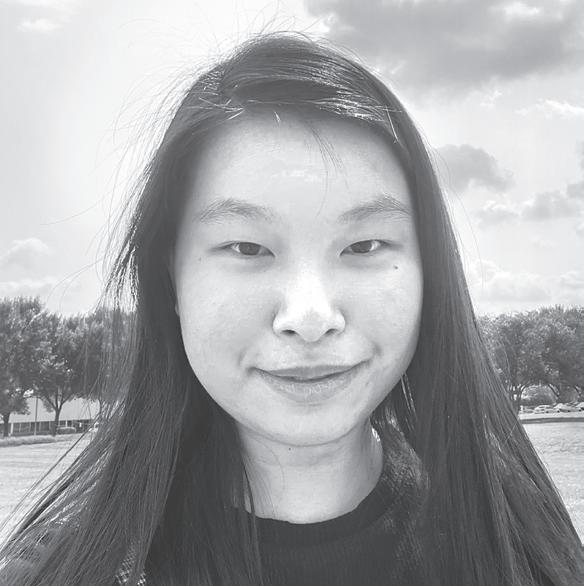
I want to thank all those passionate students who did The Sun with me: To John Colie ’23, who convinced me to join arts and brought me to my first Sun info session; To Vee Cipperman ’23, who got me to make a wholesome podcast with them during our first stressful compet season, and later brought us out of the pandemic as our valiant EIC; To Catherine St. Hilaire ’22 and Odeya Rosenband ’22 who taught us the ropes of the associate and opinion editor positions; and last but not least, To Katherine Yao ’23, my opinion editor-in-arms, who I could not have managed the opinion section without. A special thank-you to John Schroeder ’74, who has kept the heart of this paper beating for decades with his tireless dedication, and to all the alumni whose passion keeps us afloat. I am eternally grateful for all these people who have made my time on The Sun a highlight of my Cornell experience. It’s safe to say, I’m not scared of the opinion section anymore; I admire everyone who is not afraid to put their voice out there among Cornell’s cacophony. Do some exploring, don’t devalue your own voice and listen to those around you. And maybe, Cornell won’t be as cacophonous as it may seem.

of wittiness. But my column name also signaled an introduction. Hello Katie became my way of making sense of Cornell and the strange, terrible, wonderful ordeal that is college — and it allowed me a voice so that Cornell could make sense of me.
I joined The Sun as a freshman in January of 2020, and for the next four tumultuous semesters, these articles served as a constant in my life. Like clockwork, the biweekly Sunday deadline provided
learned what it meant to grow up and grow independent and raced to chronicle the small joys I had missed out on for 1.5 years.
I hadn’t planned on running for an editorship at any point, but a conversation with Odeya Rosenband ‘22 and Catherine St. Hilaire ‘22 in November of 2021 changed my mind and the trajectory of my Sun tenure. I will be forever grateful for their unwavering guidance as my editors, for answering my extensive questions about compet and, most of all, for believing in me when I was filled with self-doubt.
This column was originally published on May 12.
I’ve been accumulating snapshots for this final column since freshman year. Amorphous ideas stored in the back of my mind, half-baked phrases in the notes app on my phone, 3 a.m. text message wisdom to friends. Yet now, when I have to transform my jumbled miscellanea into coherent sentences, nothing I can write feels adequate. After all, how do you consolidate four years, one pandemic, a million existential crises and a billion more memories into a cohesive narrative?
This is the 29th and final piece that I will ever write for Hello Katie, so to say The Sun was a big part of my time at Cornell would be a gross understatement. I admittedly chose the name Hello Katie for my column because my 19-year-old brain thought wordplay on Hello Kitty was the apex
me stability through the first, daunting days of the pandemic, when my fledgling college career took a steep nosedive into uncharted waters. I documented the weeks in limbo where I had all the time in the world to ponder my existence, my major crisis (literally), my decision to stay home sophomore fall and my decision to return to campus sophomore spring. As life returned to a normal-adjacent state — and I panicked over how limited my time in the college bubble truly was — my column bore witness to a slew of upperclassman introspection. In the safety of my Google Docs, I grappled with the discombobulation of being a junior with the traditional college experience of a freshman,
My time as The Sun’s opinion editor introduced me to the most brilliant, creative community. I am beyond thankful for Emma Leynse ’23, my wonderful associate editor and Sun playlist connoisseur. Every day I wonder how I got so lucky to call you a friend. And for Vee Cipperman ’23, the best editor in chief I could have asked for (I dedicate any and all Sun puns I make in the future to you). For all the other editors and writers who poured countless hours into this organization, sacrificing sleep, school and sanity to keep the cogs of The Sun turning for 140 years and counting.
In the words of my amazing first opinion editor, Pallavi Kenkare ’21, “Working at The Sun, gleaning insight into the joys and woes and ideas of Cornellians from all over campus, was the only way to love Cornell properly.” The opinion section, especially, in all its quirky, controversial, poignant glory, has taught me more about Cornell’s eclecticism, resilience, flaws and beauty than anything else I have been a part of. To me, loving Cornell meant shining a light on these student voices, challenging the status quo and seizing the opportunity to write (and edit) Cornell’s history.
Hello Katie became my way of making sense of Cornell and the strange, terrible, wonderful ordeal that is college — and it allowed me a voice so that Cornell could make sense of me.
To any new student at Cornell, I say this: Spend time harnessing and articulating your own voice.
lar achievement like items on a grocery list. Club president? Check. Valedictorian? Check. Team captain? National Honor Society? Honor roll? Check. Check. Check.
Halle Swasing is a rising senior in the College of Arts and Sciences. Her column Goes Without Swasing ran every other Sunday this past semester.

This column was originally published on May 7.
I spent the last two weekends working at Cornell Days. When I wasn’t giving tours, I was in Klarman Hall welcoming the Arts and Sciences admits. And when I wasn’t there, I was speaking on a panel composed of ambassadors from each undergraduate college in a Bartels gymnasium filled with prospective students. I talked to a lot of admitted students and their families in the past few weeks.
By far, the most common question I am always asked in my role as a tour guide and college ambassador is, “Looking back, what do you wish you knew when you were starting college?” As a seasoned college student, about to enter my senior year, I have so many different answers to this question. One of the most frequent ones I give is that I wish I knew it was okay to let things go.
In high school, I did everything. I was a big fish in a small pond, and an ambitious one at that. I was an overachiever who liked to keep busy, so it was easy to be part of every single organization I wanted to be involved with, to take every class that interested me and to earn every achievement or recognition available. Tis is not an uncommon backstory for Cornell students. Many of us come from a place where we were the best at what we did and checked off every academic and extracurricu-
When you get to college, reality hits fast. First of all, there are way too many things to be involved with to do them all. You really have to think about what activities and involvements appeal most to you and what you really want to get out of your college experience. Ten, you have to let go of some of the things that aren’t as meaningful to you. Tis is more than just clubs and activities though. What it’s really about is the arbitrary standards you held yourself to prior to college. Massive quantities of extracurriculars is just one example. As another example, for me, learning to let go meant not making Dean’s List my top priority each semester. Before Cornell, I had been on Faculty Honor Roll every year since the start of middle school. Coming into college, I expected that streak to continue. To make the Arts and Sciences Dean’s list, however, you need to be enrolled in 15 graded credits each semester. I quickly discovered that I had semesters where I simply didn’t want to be enrolled in that many courses. I had to decide whether I was going to cling to this ridiculous standard I was holding myself to or just let go of it and base my course schedule on what was truly best for me. Once I let go, I could feel the weight of my past self’s expectations lifted off my shoulders. Past me would have viewed this mindset as underachieving. Past me would say that to look at opportunities that were perfectly within my grasp and choose not to pursue them is lazy. But guess what? I’m not past me anymore. Is it true that I am underachieving based on my past standards? Maybe. But past me also would have never believed I’d be at a place like Cornell — with one of the world’s best educations right at my fingertips — and part of some of the amazing programs I’ve found through letting go of past expectations. Past me is a lesser experienced me who had no idea what the world had in store for her, so why should I let her unrealistic standards continue to control my life? Our lives and our goals are dynamic, and they should change over time as you gain new perspectives and experiences. Underachieving according to my younger self’s standards has allowed me to focus on what really matters to me at this stage in life, and to push aside the internal and external pressures that come from growing up as a big fish in such a tiny pond. Underachieving has given me the space to experience my life in college authentically instead of conforming to the role of a cookie cutter, picture perfect student.
One of the last Peanuts strips Charles M. Schulz drew shows Peppermint Patty sitting on the ground in the rain after a football game. She seems characteristically unfazed, but nobody else appears to be around as she asks Charlie Brown for his next move. Finally, Marcie appears to tell her that everybody else has gone home: “We had fun, didn’t we, Marcie?” Peppermint Patty asks. “Yes, sir…we had fun,” Marcie responds as she walks away. Peppermint Patty has the final word as she sits alone: “Nobody shook hands and said, ‘good game.’”
Schulz himself did not know it as he worked on it, but this would mark the last time that Peppermint Patty and Marcie would appear in Peanuts. Soon after drawing this strip, he would be diagnosed with colon cancer and choose to retire the comic strip, passing away the night before the final strip was published two months later. Tis strip in question was completed before that development came to pass, but now it retroactively takes on a quality of reflecting on an entire story, and indeed an entire life, as the end draws near. We become attracted to moments or markers like this one because they provide us with a centralized and evocative image to anchor our understanding of our past and future as certain parts of our lives come to a close and blend into whatever follows next.
Knowing full well that I will soon be graduating from Cornell has granted me the opportunity to look back on this scattered, sometimes emotionally fraught four-year period of
my life and sculpt it into a more coherent narrative. Yet I am honestly not sure what that narrative could or should be. As I near the end of my time here, I must admit that I occasionally find myself at a loss for what specifically to highlight, and end up feeling a similar sentiment to that expressed by Marcie and Peppermint Patty above: I know I enjoyed a good deal of it, but I cannot always pinpoint the extent of that as we flow through each other’s lives, converging in incredible and even life-changing ways before we veer off once more into an intangible ether. Perhaps I am looking at it too fatalistically, though. I realize as I begin to contemplate my experiences more, that there are indeed many memories and other things that I will cherish as I move on. Many of these events appear somewhat commonplace at first glance but seem to represent something larger: spontaneously driving with others to Syracuse or Buffalo, making art near a waterfall with a close friend one evening, discussing the nature of life and existence after death with another friend at the height of the pandemic, making PowerPoint presentations on how each friend in a certain group would act in any given weird scenario, discussing films with another friend and so many other things. Yet these only represent one facet of my larger Cornell experience: the more positive facet, which, though I believe it will eventually succeed, cannot always offset the more negative parts that creep into my consciousness.
I do not think I would change anything concerning my time at Cornell, but, as with so many other people, I sometimes cannot stop myself from wondering how things would have turned out based on certain events. Part of that may very well be of my own making. Tere are friends I hurt by not being around for them as much as I could have, things I should have focused on more (or less) or places I should have visited more frequently. Perhaps the alternatives would have made me feel worse, but all the same, I would be lying if I said I enjoyed my entire experience on Te Cornell Daily Sun. I would be lying if I said I enjoyed my entire experience at Cornell. As much as everything else makes up for them, those sentiments still remain.
Te negative facet also possesses another, more unexpected component: I have not had a typical final semester, thinking back on this era of college while looking forward to what the “real world” holds in store. Instead, one experience that has remained in my mind for much of these final months is not related to Cornell or the end of college at all. It is one I wished I never had to go through.
On March 15, my grandmother was killed in a fire. I am still uncertain of all the details, but I did hear the following:
Whipped up by gusts of wind apparently traveling at over 50 miles per hour, the fire quickly spread to the entire structure. In only 30 minutes, the entire house was gone, and she was dead. It was only later that I realized that this happened four years to the day that I found out I had been accepted to Cornell.
Considering how everything happened, my mind keeps returning to the photographs of the house ablaze. Its frame still stands defiantly as it becomes engulfed in flames, the round window at the front awash with orange as the shingles and other elements of its structure begin to blacken; the plastic bars of the railings, melting and expanding from the heat, bend outwards like some horrible skeleton. Black smoke billows up into a clear, dark blue sky, the scene devoid of any sort of human presence. My family, along with my father’s two siblings and their families, had visited this house since before I was born, yet now, it was reduced to rubble that firefighters still needed to douse with water to ensure the fire was extinguished, even after all of it was torn down.
I still have barely any idea what to think. My grandmother was 92 years old and suffered from severe dementia and possibly Alzheimer’s disease; one of the last times I saw her alive was in the hospital in New Jersey, as my family started preparing ourselves for her imminent final decline and death, like that of my grandfather, also from dementia, four years prior. It seemed like it would happen sooner than later. But not like this.
Of course, everything was destroyed, the home reduced to formless rubble left at the site for days on end. It is inescapable, too: Most of the photographs of her are inside that house, serving as ghastly reminders of everything that has been lost even as they prove to be the most vivid way to celebrate her memory.
To make matters worse, the Melkite Catholic faith that my family follows holds open-casket funerals, but the condition of her remains was such that the coffin remained closed, covered with a white burial shroud as we sang to her memory in English, Arabic and Greek.
To continue reading this story, please visit cornellsun.com.

To be in this place at this time. It is a sensation, as uninspired as it sounds, of being alive.
Our lives and our goals are dynamic, and they should change over time as you gain new perspectives and experiences
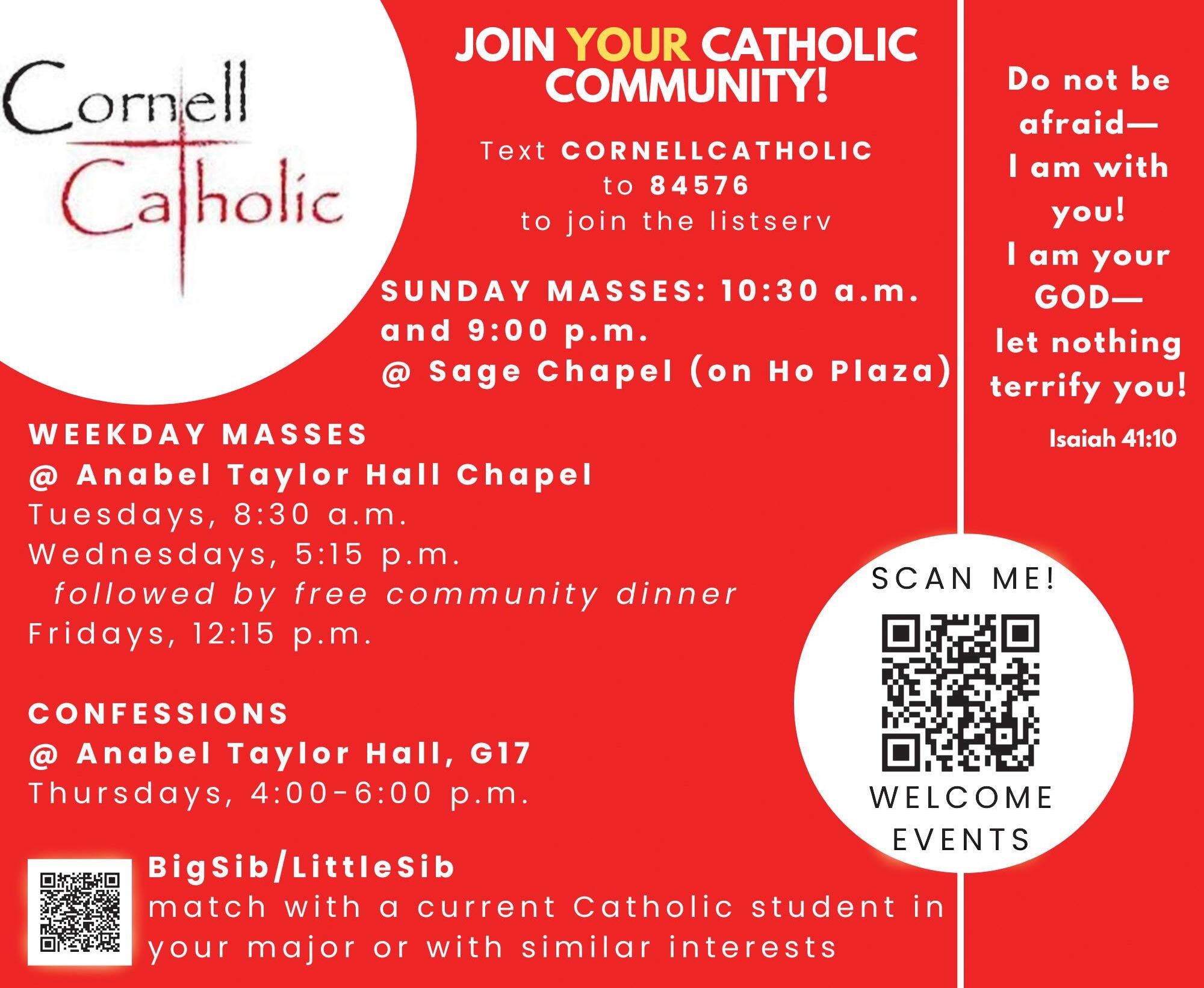

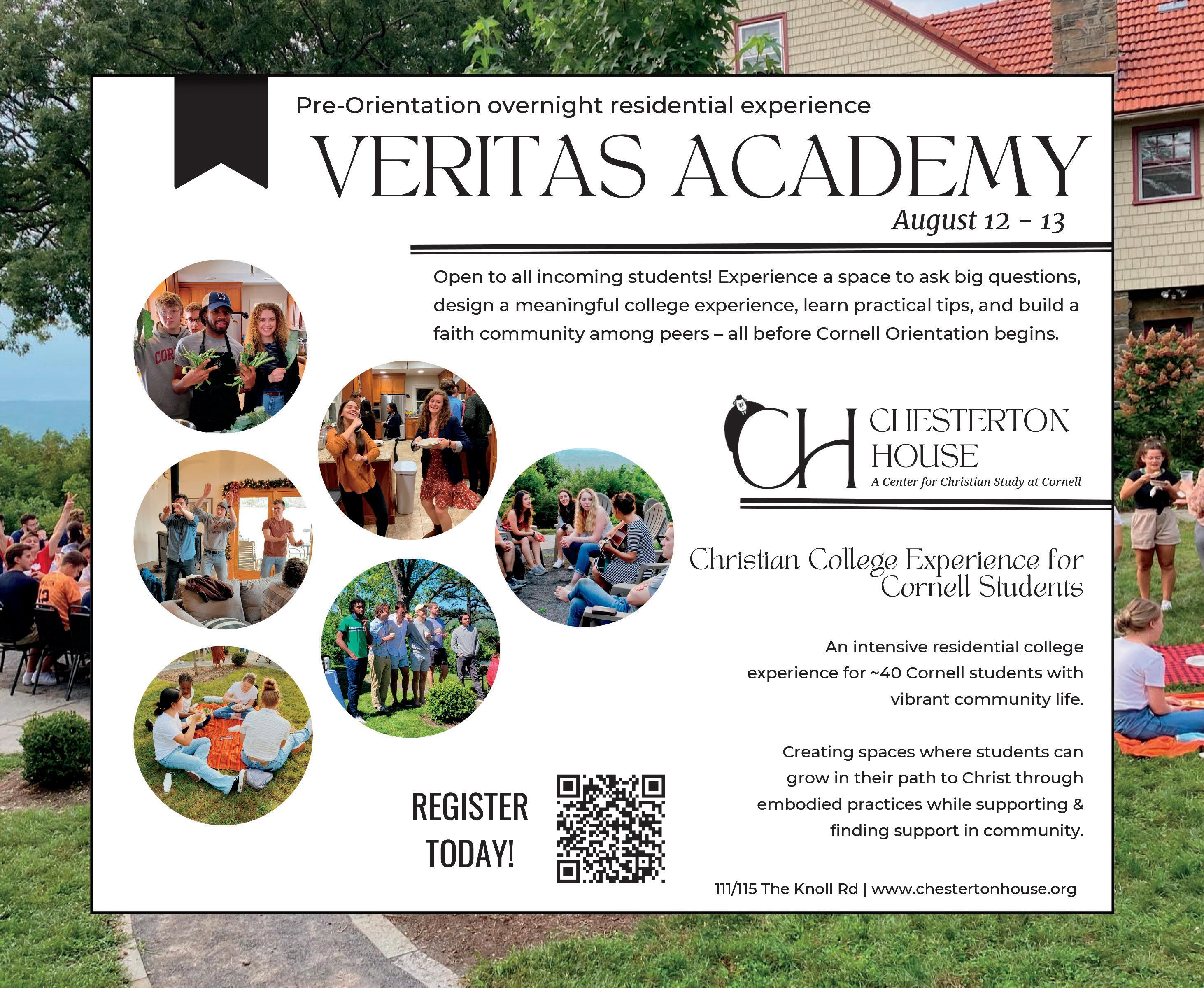




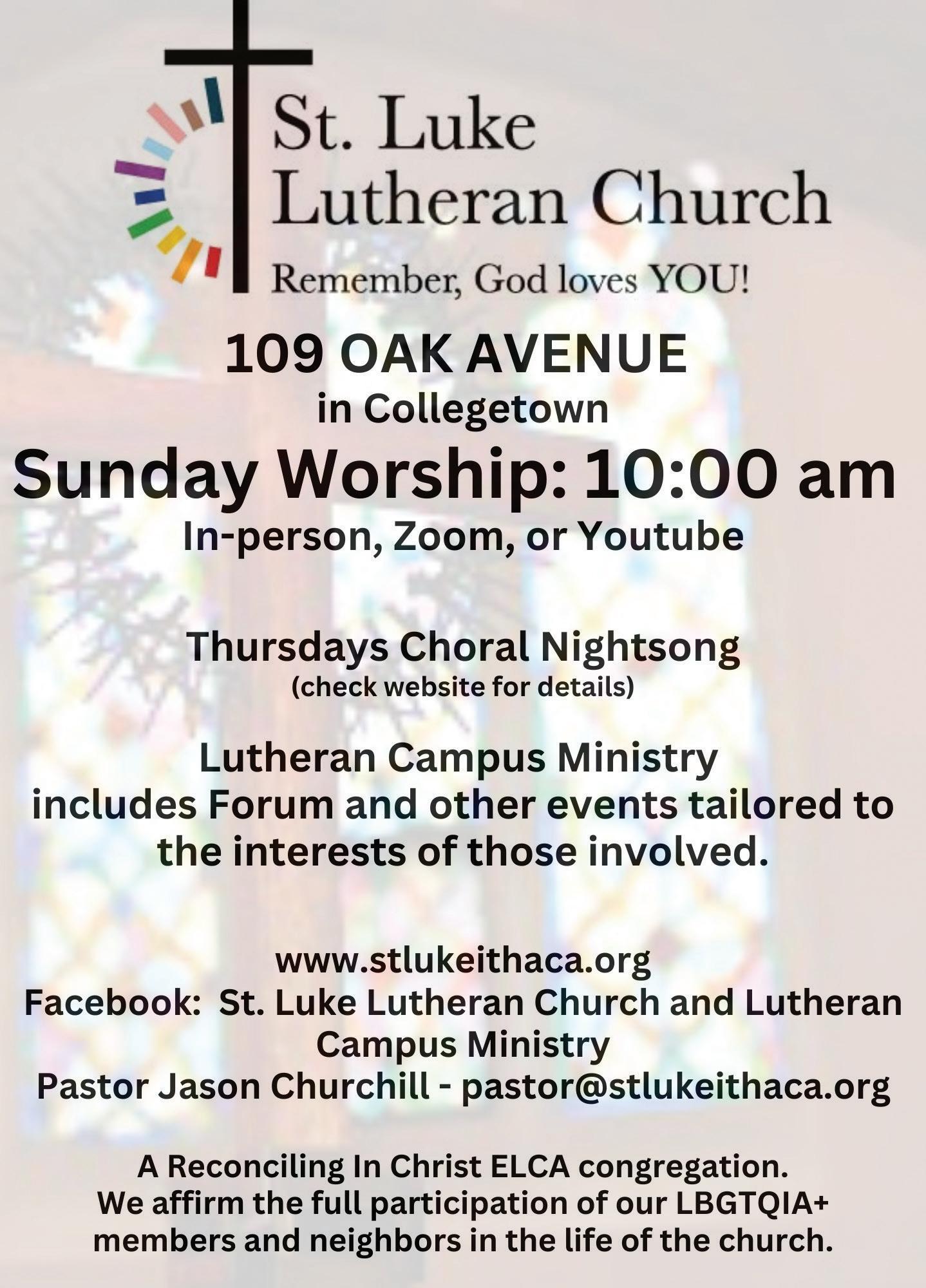

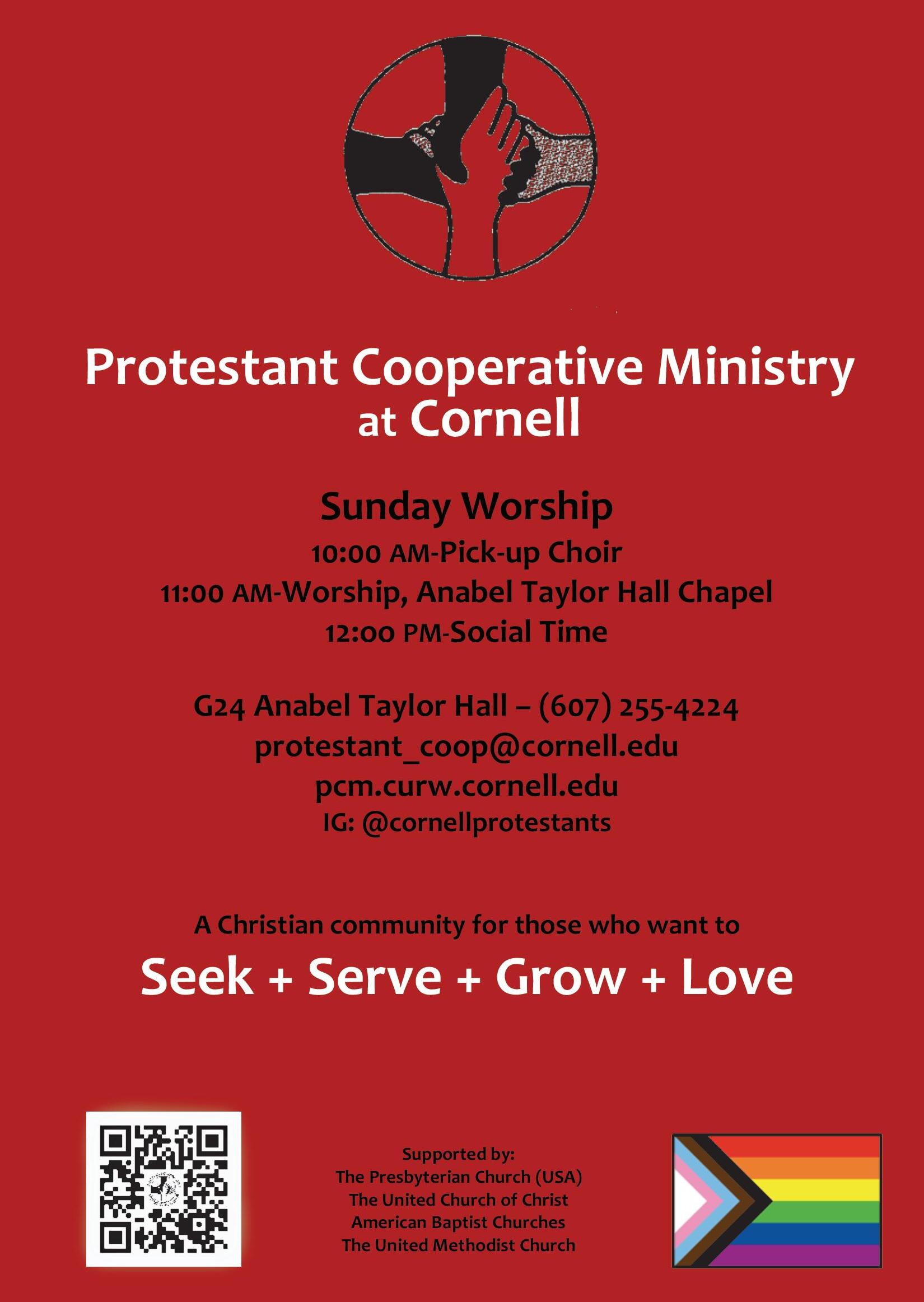
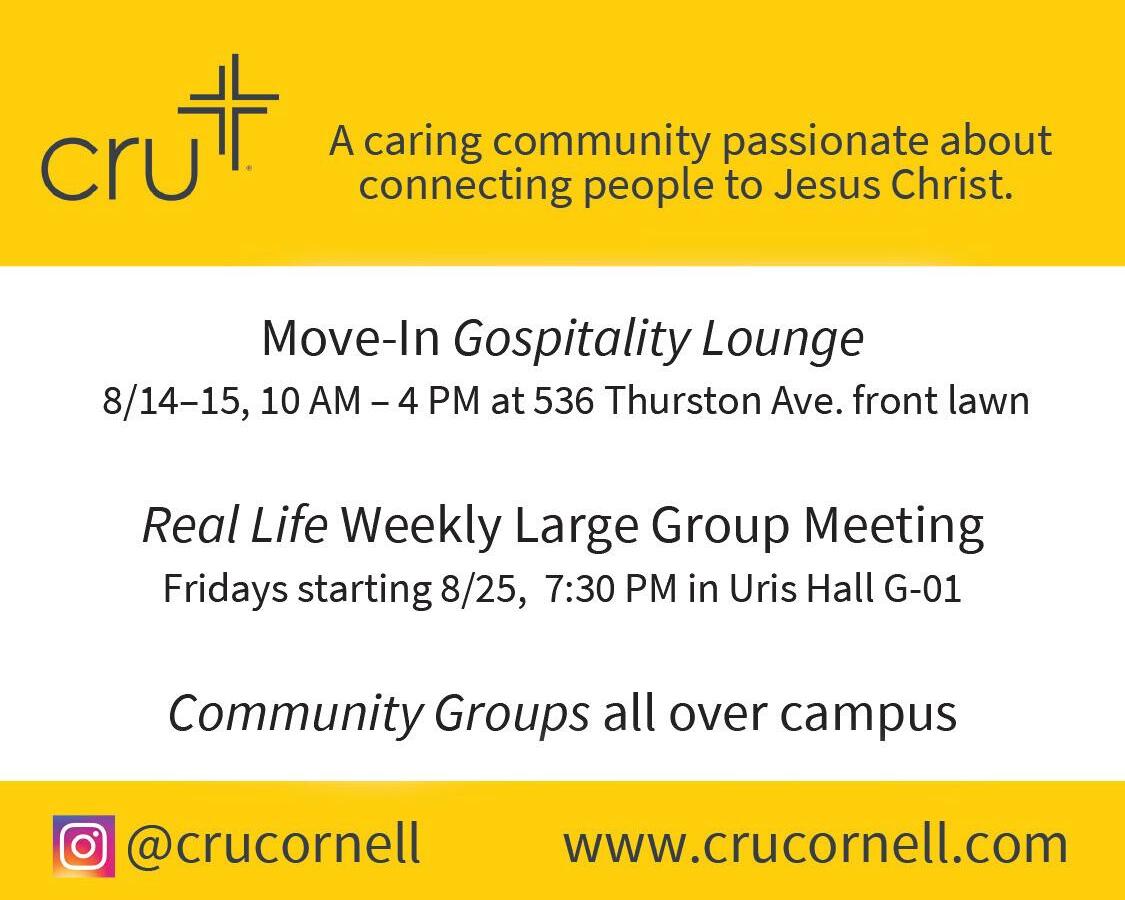





This article was originally published March 8.
President Martha Pollack expressed support for Student Assembly’s Resolution 20 — which proposes increased access to nonprescription health care supplies, including contraception — in an email response to the S.A. on March 7.
“I support efforts to expand access to non-prescription health care supplies, including contraception,” Pollack wrote. “Cornell Health and campus partners are currently reviewing a proposal for such supplies to be made available via campus vending machines and I encourage your continued collaboration with them.”
The S.A. passed Resolution 20 on Thursday, Feb. 9, and the University Assembly conveyed their version of the proposal — Resolution 5 — to President Pollack on Thursday, March 2.
According to an email obtained by The Sun, President Pollack responded to Duncan Cady ’23, chair of the U.A. and an S.A. undesignated representative-at-large, who also co-sponsored Resolution 5 and Resolution 20.
On March 6, the Graduate and Professional Student Assembly also passed Resolution 7, their version of the proposed resolution.
Resolution 20 aims to implement vending machines with nonprescription medicine and emergency contraception around campus. Several members of the S.A. — including Sanvi Bhardwaj ’24, the College of Human Ecology representative, and Shelby Lynn Williams ’25, a College of Arts and Sciences representative — said they were pleased by Pollack’s support of the resolution.
Bhardwaj emphasized the resolution’s importance in improving healthcare access at Cornell.
“This is critical for increasing health accessibility and equity on campus, as Cornell Health is far for many students, not open 24/7 and the generic version of Plan B they carry is significantly cheaper than the name-brand version offered at most pharmacies,” Bhardwaj wrote in a statement to The Sun.
According to a survey conducted by Cornell University Planned Parenthood Generation Action, increased emergency contraception access is both necessary and desired.
Out of approximately 700 respondents from the Cornell community, 53.3 percent said that they have accessed emergency contraception for themselves or another person and 90.32 percent said that they would feel very comfortable or strongly comfortable accessing emergency contraception from a campus vending machine operated by Cornell Health.

Katherine Esterl ’24, co-president of PPGA, also noted that Cornell’s physical isolation from the greater-Ithaca area poses a transportation barrier for
students seeking reproductive health care.
“It’s not like you can walk outside your dorm and walk five minutes to a CVS. And it’s also not like you can walk outside your dorm and walk five minutes to Cayuga Health to get an appointment with an M.D. gynecologist… even [going] downtown to the Planned Parenthood can be a barrier,” Esterl said. “I think the vending machines are a pretty easy fix for access.”
Bhardwaj, Williams and Cady also highlighted the resolution’s importance within the current political climate.
“I think this resolution is important as part of improving our University’s health access and health equality, but especially relevant post-COVID and post-Dobbs,” Cady, who is also a general body member of PPGA, told The Sun, referring to the U.S. Supreme Court reversing Roe v. Wade on June 24, 2022, ceasing the constitutional right to abortion in the United States.
Marley Levy ’24, PPGA general body member who helped develop the initial idea to implement vending machines, said that she hopes Pollack’s acknowledgment of Resolution 20 will be a first step toward greater reproductive health equity on campus, citing the President’s lack of support for S.A.’s Resolution 15 — which aimed to fund an M.D. gynecologist on campus.
“I am pleased, yet surprised, at [Pollack’s] support of Resolution 20. I hope it is just the start [of] greater access of needed sexual and reproductive strides on campus,” Levy wrote in a statement to The Sun. “I would like to see measurable progress on this resolution before the end of the semester, as President Pollack said in her email to Student Assembly members.”
PPGA co-president Taisa Strouse ’24 also expressed surprise at Pollack’s support, adding that her support for Resolution 20 contradicts her refusal to accept Resolution 15.
“Her hypocrisy is clear,” Strouse wrote in a statement to The Sun. “The intention of the Plan B vending machine is based on the inaccessibility of Cornell Health — due to weekend closures and limited hours — and off-campus medical facilities. Thus, Pollack’s justification that there are ‘several gynecology providers in the Ithaca community’ in her refutation of Resolution 15 is unfounded and disappointing.”
Despite Pollack’s acknowledgment of the resolution, Bhardwaj expressed skepticism regarding whether the President’s support would lead to action.
To continue reading this article, please visit www.cornellsun.
By JONATHAN MONG Sun News EditorThis article was originally published Feb. 7.
The Yellow Deli, operated by the Twelve Tribes community, opened in the Commons on Jan. 1 at the same location as their previous establishment, Maté Factor.
According to their website, the Twelve Tribes, also known as the Commonwealth of Israel, are a religious group where families and individuals live together in communities. They have a worldwide presence, scattered throughout every continent except Africa.
Founded by Gene Spriggs in 1972 in Chattanooga, Tennessee, the Twelve Tribes encourages members to live as adherents to the early church, emphasizing its communal aspect — the Denver Post reported in 2022 that new members must sign over ownership of all of their possessions to the group’s limited liability companies.
The Ithaca branch has been present for about 20 years, according to Marcel Campbell, a worker at the Yellow Deli and a lifelong member of the Twelve Tribes. As the branch is located on 119 Third Street, their presence has attracted negative attention from the Ithaca community for years.

“It is also my understanding that generally most Ithacans are at least somewhat aware that the Twelve Tribes is a religious cult and thus the appeal [of the Yellow Deli] would be more to university students, visitors and tourists who are only here temporarily,” said Ian Stewart ’23, a student who has lived in Ithaca for 31 years.
When the group arrived in Ithaca in 2003, they held an open forum to address concerns about their presence, but twenty years later, the group still remains.
“Choosing to go commercial on the Commons is basically an unannounced front for a cult,” said Pastor Steve Felker of Christ Chapel in Ithaca to The Sun in 2006. “I felt like it was important to
[shed] light on what they stand for, so that the community understands what they are spending their dollars on at the commons.”
Similarly, Stewart’s early memories of the Twelve Tribes were negative.
“They casually strew pamphlets and brochures around the café that laid out their beliefs in the coming end times, or other such concepts,” Stewart said. “They were never overt in their more disturbing opinions and it is my own belief that this was deliberate, as a means of getting outsiders interested before explaining the more unsavory beliefs, much like other cults.”
However, Ithaca is not unique in its distaste for the Twelve Tribes, who have also attracted controversy from localities across the United States for their views and labor practices.
In an investigation, the University of Colorado Boulder’s newspaper the CU Independent found accusations of child abuse after interviewing former members of the organization. A publicly accessible copy of the Twelve Tribes’ “Child Training Manual” specifically encourages parents to use physical dominance to assert dominance over their children in various ways. It is unclear whether or not this document applies to the Ithaca branch of the Twelve Tribes.
According to the manual, “a child needs to learn that his disobedience results in receiving his parents’ disapproval. The parents’ controlled use of pain is not cruel and will not cause the child to fear his parents personally. He will only learn to respect their word and the authority they possess … The minor discomfort a child must experience in order to learn to obey his parents’ commands will save him much pain in the future.”
A fundamental tenet of the 348 page “Child Training Manual” is that pain ought to be the element of control over a child.
To continue reading this article, please visit www. cornellsun.com.
NAME: James De La Vega
GRADUATED: B.F.A. 1994
WHAT TO KNOW: This widely-revered, New York-based street artist deals primarily in chalk, creating thought-provoking, aphoristic works that have garnered acclaim not only in the States, but also in Italy and Japan as well. De La Vega has, like any worthy artist, been at the center of controversy. Since, legally, his works qualify as graffiti, he has been taken to court and sentenced on vandalism charges. De La Vega, when not working on his next mural, tours the country as a motivational speaker, talking about freedom of expression, art and working in the face of adversity.
NAME: Robert Trent Jones
GRADUATED: 1931
WHAT TO KNOW: While at Cornell, Jones took such disparate courses like landscape architecture, public speaking, agronomy, economics, surveying and hydraulics, to pursue a career as a golf course designer. Jones’ work on over 500 golf courses, including Montauk Downs, Augusta National and Cornell’s own Robert Trent Jones Golf Course, earned him a spot in the World Golf Hall of Fame. Jones’ courses have had an indelible effect on the modern game, encouraging risky play and emphasizing tasteful, original aesthetics.
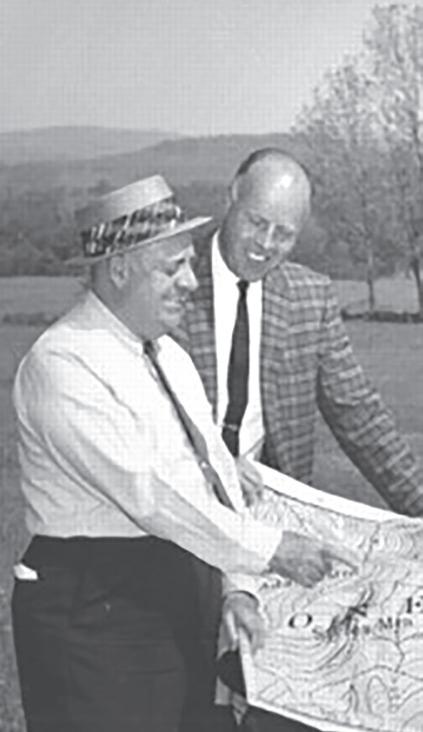
NAME: E.B. White
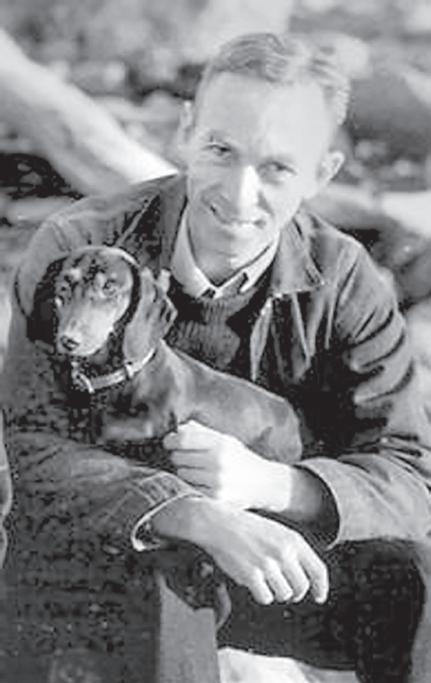
GRADUATED: B.A. 1921
WHAT TO KNOW: White was as dynamic a writer as you could get. A long-time contributor to The New Yorker, White was also responsible for two classic children’s books, Charlotte’s Web and Stuart Little The former Sun editor in chief co-authored one of the definitive guides to English grammar, syntax and style, The Elements of Style, with William Strunk Ph.D. ’96.
NAME: Junot Diaz

GRADUATED: M.F.A. 1995
WHAT TO KNOW: Diaz is a renown writer best known for his short stories. His most famed book titled “The Brief Wondrous Life of Oscar Wao” won the 2008 Pulitzer Prize and the National Book Critics Circle Award. He is now a creative writing professor at the Massachusetts Institute of Technology.
NAME: Nicola Yoon
GRADUATED: B.S. 1994
WHAT TO KNOW: Yoon is a famous Jamaican-American writer best known for her modern books, which have been the subject of many well-known movies, including “The Sun is Also a Star” and “Everything, Everything.” Yoon got her great writing skills right here at Cornell.
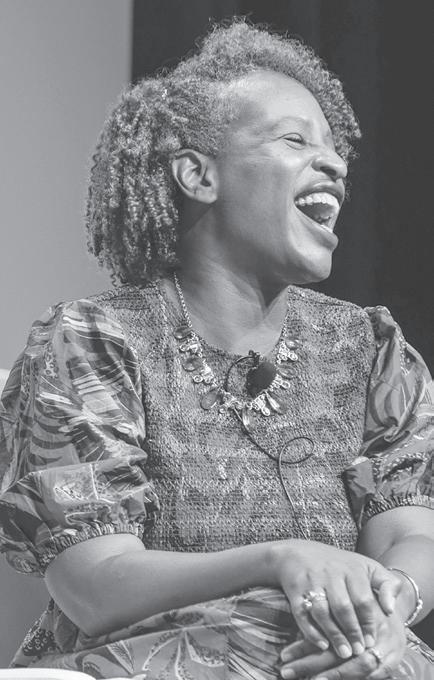
NAME: Peter Eisenmann

GRADUATED: B.Arch. 1955
WHAT TO KNOW: Incoming architecture students are sure to be aware of Eisenmann’s significant contributions to architecture. As one of the leaders of the deconstructivist movement, Eisenmann incited his fellow architects to liberate the form of their works from external references. His works range from convention centers (The Greater Columbus Convention Center) to memorials (The Memorial to the Murdered Jews of Europe) and football stadiums (University of Phoenix Stadium).
NAME: Harry Chapin
GRADUATED: Dropped out in 1964
WHAT TO KNOW: Chapin is a renown for his work as an American singer and songwriter. The performer was best known for his career in filmmaking, and his group that he was part of with his brother, called the Chapin Brothers. Chapin was also active in many charitable causes. While he never graduated from Cornell, he walked the same steps as all of you will.


NAME: Steve Reich
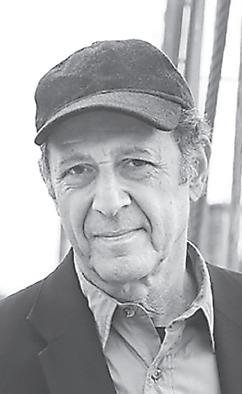
GRADUATED: B.A. 1957
WHAT TO KNOW: Reich’s work as a composer is highly influential across many genres — artists like Sonic Youth, Brian Eno and Sufjan Stevens cite Reich as an influence. Reich’s usage of tape loops, minimalist instrumentation and repetition put him in an elite category of modern composers. Reich was awarded with the Pulitzer Prize for his Double Sextet in 2009.
NAME: Huey Lewis
GRADUATED: Dropped out in 1969
WHAT TO KNOW: A strong rock vocalis and a talented harmonica player, Huey Lewis, the frontman of Huey Lewis and the News, dominated 1980’s radio with his band’s third album, Sports. Lewis also made appearances backing up Elvis Costello on My Aim Is True and playing harmonica on the legendary Thin Lizzy live album, Live and Dangerous

LAURENS HAMMOND 1916
After receiving his B.S. in mechanical engineering in 1916, Hammond would go on to create the electric Hammond organ, which proved to be an important milestone in electronic music’s evolution and influential to the genres of jazz and progressive rock.
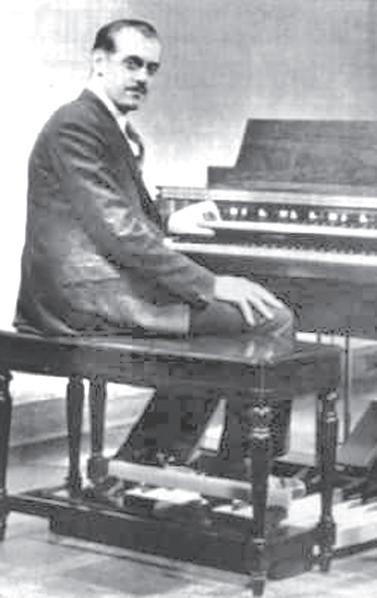
THOMAS
Honing his literary chops under the likes of Vladimir Nabokov at Cornell, Pynchon would go on to define the postmodernist tradition, winning the National Book Award for 1973’s Gravity’s Rainbow

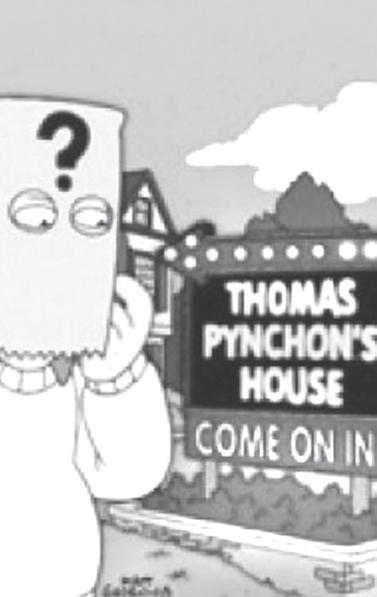
Buck used the skills she honed at Cornell to craft some of the 1930s’ best-selling and most acclaimed historical fiction. She would go on to win a Pulitzer Prize for The Good Earth in 1932 and a Nobel Prize in 1938.
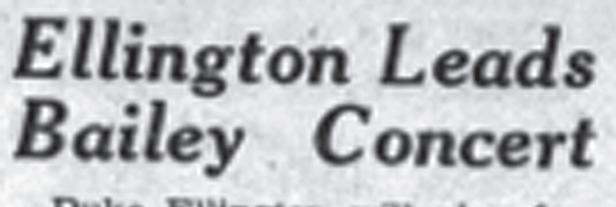

Years after leaving Ithaca with a degree in English, Seidler took the stage to accept the Academy Award for Best Original Screenplay for The King’s Speech in 2011.
Laurents penned and directed a number of seminal Broadway musicals, including West Side Story, Hallelujah, Baby! and La Cage Aux Folles, in addition to writing a number of well-received films.
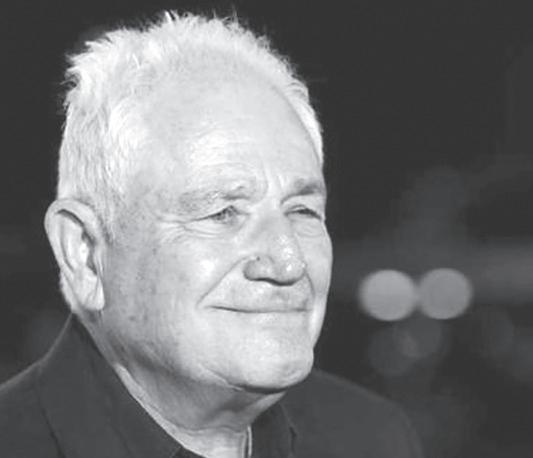

TONI MORRISON M.A. ’55
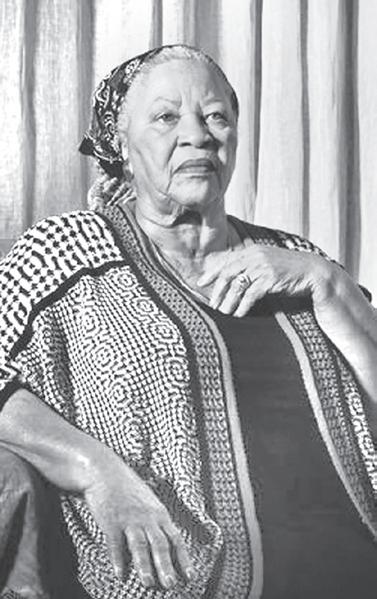
The acclaimed author has won a Pulitzer Prize, the Nobel Prize in Literature and the Presidential Medal of Freedom for her prolific, vivid novels, including Beloved
Prior to leaving Cornell to fight in the second World War, Vonnegut pursued a degree in chemistry and served as the associate editor of The Sun. Throughout the 60s and beyond, he established himself as one of counterculture’s most notable novelists with the satirical black humor of books like Slaughterhouse-Five and Cat’s Cradle
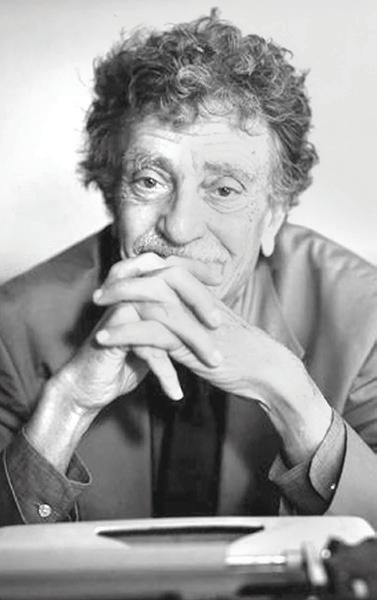 KURT
KURT

If the origins of popular electronic music can be traced to one person, it would be Robert Moog. While at Cornell studying engineering, he grew interested in and began developing electronic instruments. His Moog Synthesizer would go on to be the tool of choice for everyone from Beaver & Krause to Donna Summer.
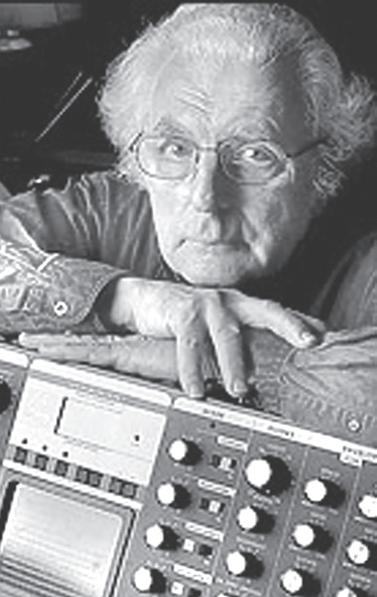
After revitalizing the Southern California punk scene, the lead singer of Bad Religion turned his focus to doctoral biology work and has lectured courses on evolution at Cornell.
Before the world knew him as Superman and a philanthropist, Reeve starred in numerous Cornell theater productions.
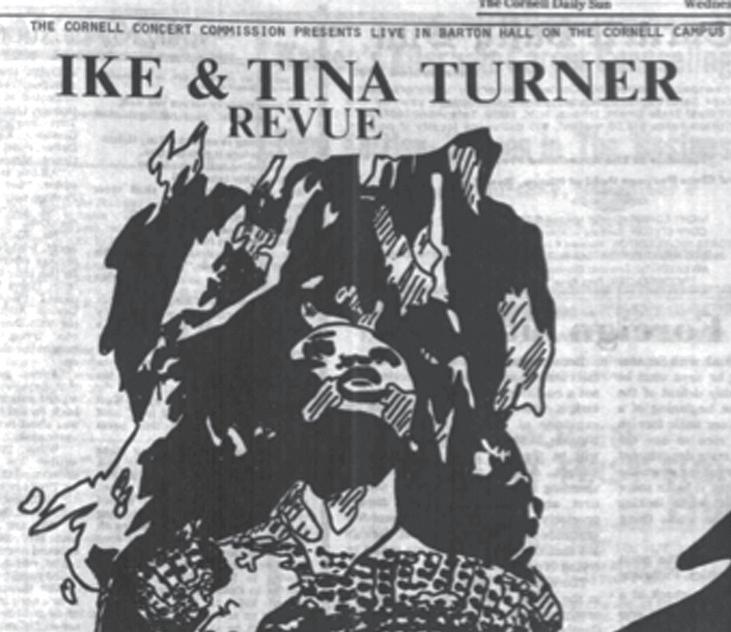

Following a few notable feature-length comedy roles in films such as The 40-Year-Old Virgin and Role Models, Lynch raked in the awards with her regular role on the hit show Glee

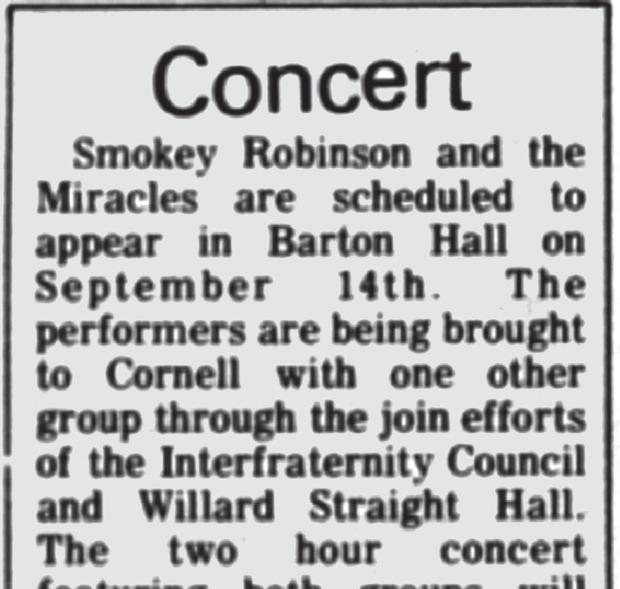

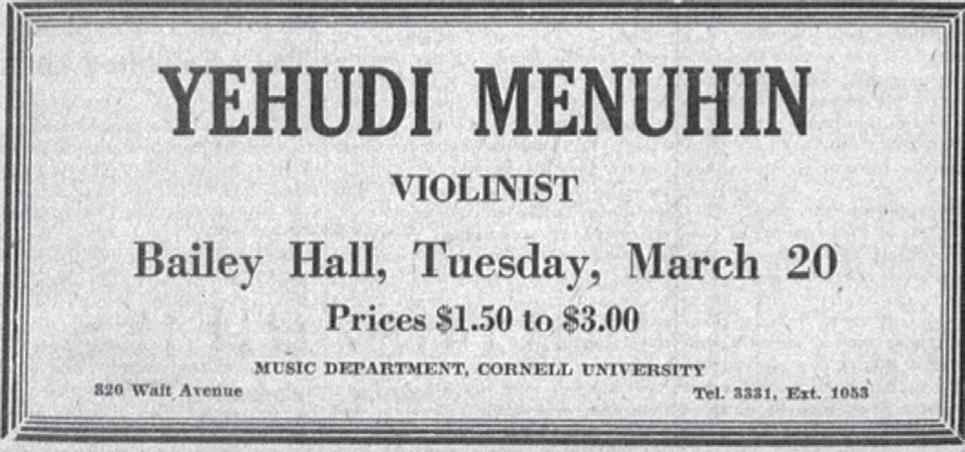
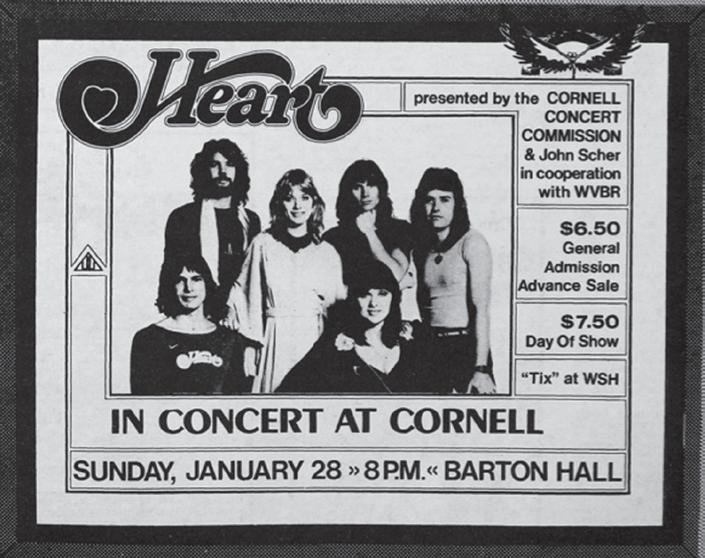
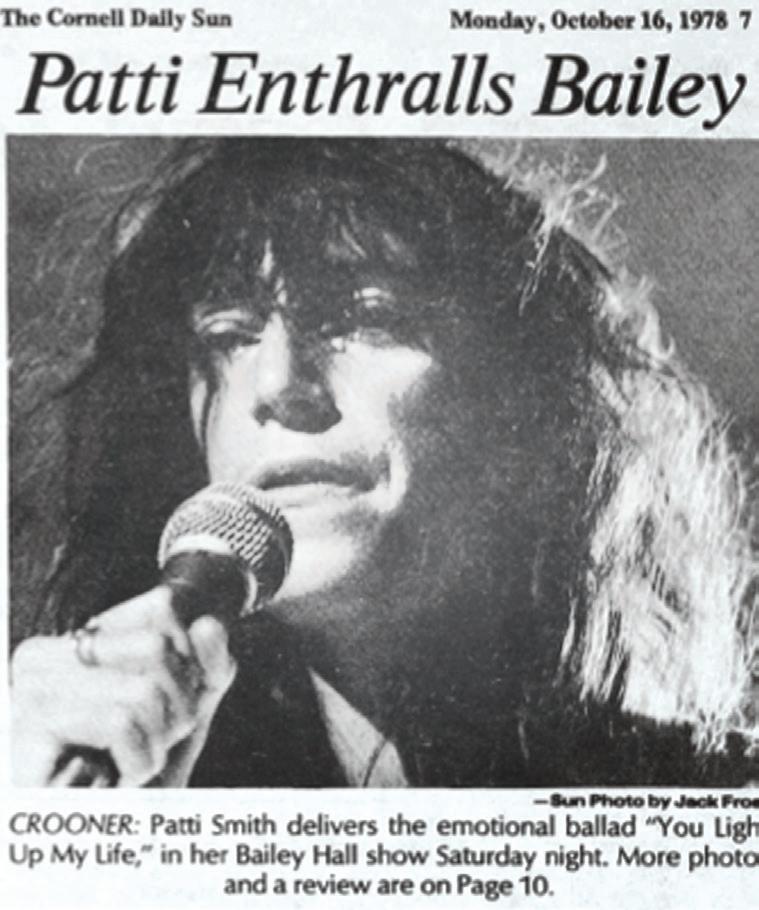
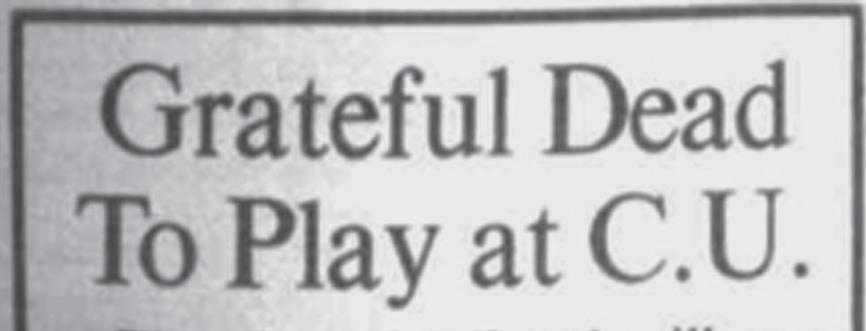
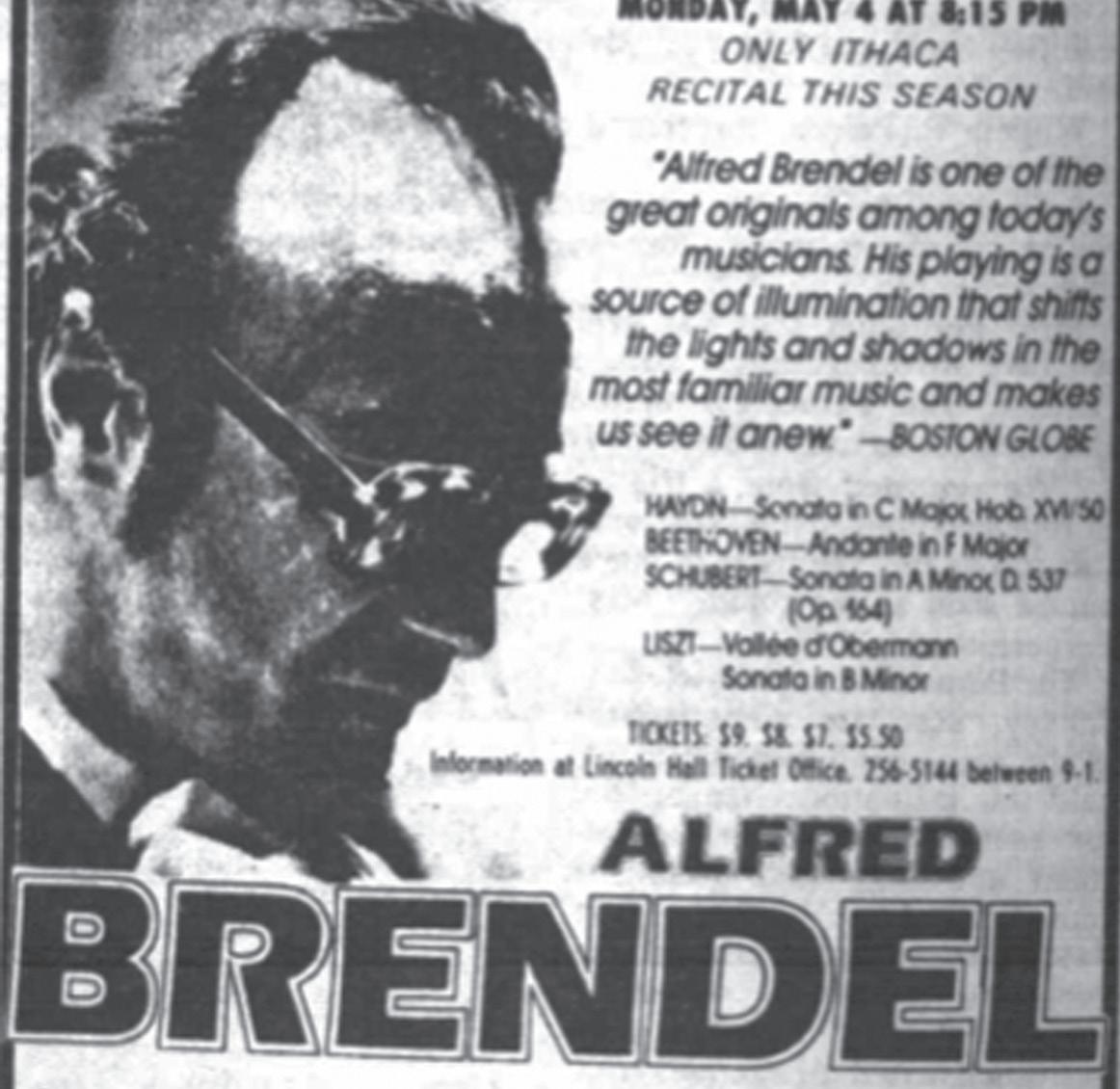

For 150 years, Cornellians have come together for live music. From harps to hip-hop, Barton to Bailey and Spring Day to Slope Day, concerts have been a cornerstone of the student experience. Over the years, our campus has been host to violin virtuoso Yehudi Menuhin, the second-most-downloaded Grateful Dead show, Kanye West in support of The College Dropout and everything in between.

Your source for good food
This story was originally published on July 28, 2018.
According to Forbes magazine, Americans are eating alone more and more often. And from a practical viewpoint, it makes a lot of sense. Eating alone is efficient; you can finish quickly and attend to the next item on your to-do list. You can even catch up on a TV show or watch sports highlights. Or if you’re really desperate,
here and at many other college campuses across the nation. Why? Well, let’s face it, eating with others is hard to do in college. With Cornell’s myriad of classes and extracurriculars, everyone has a different schedule. Although it can be hard to find the time for it, sharing a meal with others can be one of the best ways to build a deeper relationship with the people around you. So, firstyears, I strongly encourage you all to make the time in your schedule to share your meals with others, especial-
heard stories about how the department used to be in Newman Hall.
The first few weeks of your first year here can be really tough and isolating, so don’t be afraid to ask people you’ve just met to grab a meal with you. Whether it’s lunch between classes or dinner after a club meeting, sharing a meal is a great way to make new acquaintances and build close friendships. People tend to be more relaxed during meals, which allows for great conversation to happen naturally. Plus, sharing food helps you get to know someone better easily since food is a key part of a person’s identity. Learning about the food they enjoy eating and making reveals a lot about someone’s background and upbringing, helping you to form a more meaningful friendship.
By REVA RAO Sun Staff WriterThis story was originally published on April 24.

With over 10 dining halls and 18 cafés scattered throughout Cornell’s campus, each boasting their unique strengths and weaknesses, Cornell dining can be overwhelming for a freshman to navigate. Throughout my first year at Cornell, I found myself trying out different places, but taking random guesses at what to order. If you’re keen to discover the tastiest menu items and fit in like a true Cornellian, know that you’re not alone. Thankfully, I’ve compiled a list of the top five hidden gems at Cornell eateries, complete with specific recommendations on what to order, as not all menu items are created equal.

love their egg sandwiches. Personally, I have a sweet tooth, so I tried creating my own bagel from their menu. I chose a cinnamon raisin bagel and added Cornell’s honey roasted peanut butter, cinnamon sugar creamed honey, mixed berry cream cheese and banana.
Too extra? Perhaps.
The bagel was soft and fluffy with a delightful cinnamon flavor. The honey roasted peanut butter was creamy and salty, which balanced out the sweet cinnamon sugar honey. The mixed berry cream cheese was smooth and luscious, and the fresh berry flavor was a lovely addition. The banana slices completed the whole experience adding a delicate, sweet flair. It was a fantastic combination of flavors that I highly recommend trying.
Whipped Cream Cheese
Mac’s Smoothies
Mac’s is a vibrant café situated right in the heart of the Statler. Although the majority of customers are Hotel School students, don’t let that deter you from trying their exceptional smoothies — in my opinion, the best at Cornell. They offer a variety of fruit and frappuccino-style drinks, and I highly recommend trying two of them.
The first smoothie, known as the cookies and cream frappuccino, falls somewhere between a frappuccino and a milkshake. It delivers a much-needed caffeine boost, a sugar rush and the delectable taste of oreo cookies and milk. While it’s not an everyday drink, it’s definitely a treat worth indulging in!
you can catch up on work.
I know I have eaten alone and done all of the things I’ve listed. And to be honest, it kind of sucks. Eating alone makes me feel lonely and small. Every day, I notice plenty of people eating lunch or dinner alone in the dining halls; it’s incredibly common
ly your professors! During the semester, some professors will invite students to get a group meal with them. Not only is it usually casual and less stressful, but you also get to learn about the unique experiences of your professors. I remember I once got dinner with a professor emeritus in the physics department and
As the years go on and you move away from dining hall food, keep setting time aside to share food with the people you care about. For example, a few friends and I decided to make time every month to get a meal together this year, regardless of prelims. I don’t see them on a dayto-day basis, so it’s nice to check in with each other. So far, every time we’ve gotten a meal together, our friendship grows stronger.

Although I am not a huge bagel enthusiast, I do enjoy visiting Bus Stop Bagels when I crave them. Bus Stop Bagels is a cozy, inviting bagel shop located conveniently near the agricultural quad. There are a mix of booths and seats inside to sit, however, at busy times there are lines that run out the door. Bus Stop Bagels offers both savory and sweet bagels, and many people
Although you can always order a regular egg and cheese bagel, I encourage you to experiment with different spreads and flavors. Here are some mouthwatering combinations to consider if you want to try something new:
1. Cinnamon Raisin Bagel + Honey Roasted PB + Nutella + Banana
2. Cinnamon Raisin Bagel + Blueberry Apple Butter + Honey Roasted PB + Honey Walnut Whipped Cream Cheese
3. Spicy Italian + Basil Pesto + Bacon Scallion
The second smoothie is perfect for those who prioritize health and fitness. Even those who despise vegetables rave about the Green Smoothie. Its secret ingredient is spinach, which is indetectable amidst the fruit and orange juice that compile the other ingredients. Be prepared for long lines during peak times, but trust me, it’s well worth the wait, especially on a hot summer day.
Louie’s Lunch, situated adjacent to Risley Hall, has become a well-known food truck due to its convenient location, fast food-style offerings and extended hours until 3 am. It’s not surprising that Louie’s is busiest during late-night hours, attracting a diverse clientele, ranging from hard-working students seeking a respite from latenight studying to partygoers looking for a quick bite after a frat party. While some students may frequently complain that Louie’s Lunch food is too greasy, the reality is that after a long day, grease can be just what the doctor ordered. The real standout at Louie’s however are their customizable milkshakes. With virtually any flavor combination possible, you can create your dream shake. Personally, I have two go-to favorites: the Peanut Butter and Chocolate, and the Strawberry and Chocolate. Other flavors include Caramel, Maple, Mint, Mango, Banana and Vanilla.
To continue reading this story, please visit cornellsun. com.
While we believe that Cornell looks the most beautiful at the start of the fall semester, it is also unfortunately the most unbearably hot during that season. To beat the heat and cool down after a back-breaking, sweat-inducing move-in weekend, we recommend heading out for some ice cream, which is also an opportunity to explore the city of Ithaca. Below are three recommendations (in no particular order) for all you incoming freshmen and your families:
CORNELL DAIRY BAR
411 Tower Rd. (Stocking Hall)
If you want to stay on campus and still get some exceptional ice cream, then stop by Cornell Dairy Bar, which actually made a limited edition flavor of ice cream (“Big Red, White & Biden”) in honor of self-proclaimed ice cream fanatic President Joe Biden, who was the Convocation speaker for Class of 2017.
For the past 138 years, Cornell Dairy Bar has been creating ice cream from the university’s cows and currently offers 20 different flavors, some which you’ll notice are offered in our dining halls. If you want to have Cornell Dairy’s entire selection in front of you, then I recommend you pay a visit to Stocking Hall, where the Dairy Bar is located (otherwise, you can find tubs in all campus dining halls). You definitely don’t need to drive a car or take the bus, as it is located on campus and is about a 20-minute walk from North Campus. When you arrive at Stocking Hall, you’ll notice the large, white sculpture of a milk bottle out front.
After trying all 20 flavors, some of our favorites are Bavarian raspberry fudge and Kahlua fudge. Bavarian raspberry fudge is “vanilla custard ice cream with old-fashioned fudge pieces and a raspberry swirl,” and reminds us of raspberry cheesecake. It’s smooth, and the little punches of raspberry and fudge complement each other. Kahlua fudge is “Kahlua ice cream with a chocolate fudge swirl.” Ezra’s morning cup, another Cornell Dairy Bar flavor, also has a coffee flavor, but Kahlua fudge is much stronger and thus satisfying.
Because the Dairy Bar is located in the lobby of Stocking Hall, there’s plenty of seating around the shop. And Stocking Hall was renovated a few years ago, so the place has a casual and modern vibe, given its clean lines and all-white interior.
Founded in 1936 by Cornell alum Leo Guentert 1920, Purity Ice Cream may be located the farthest from campus of the three establishments in this list, but it has the greatest variety in terms of both flavors and products.
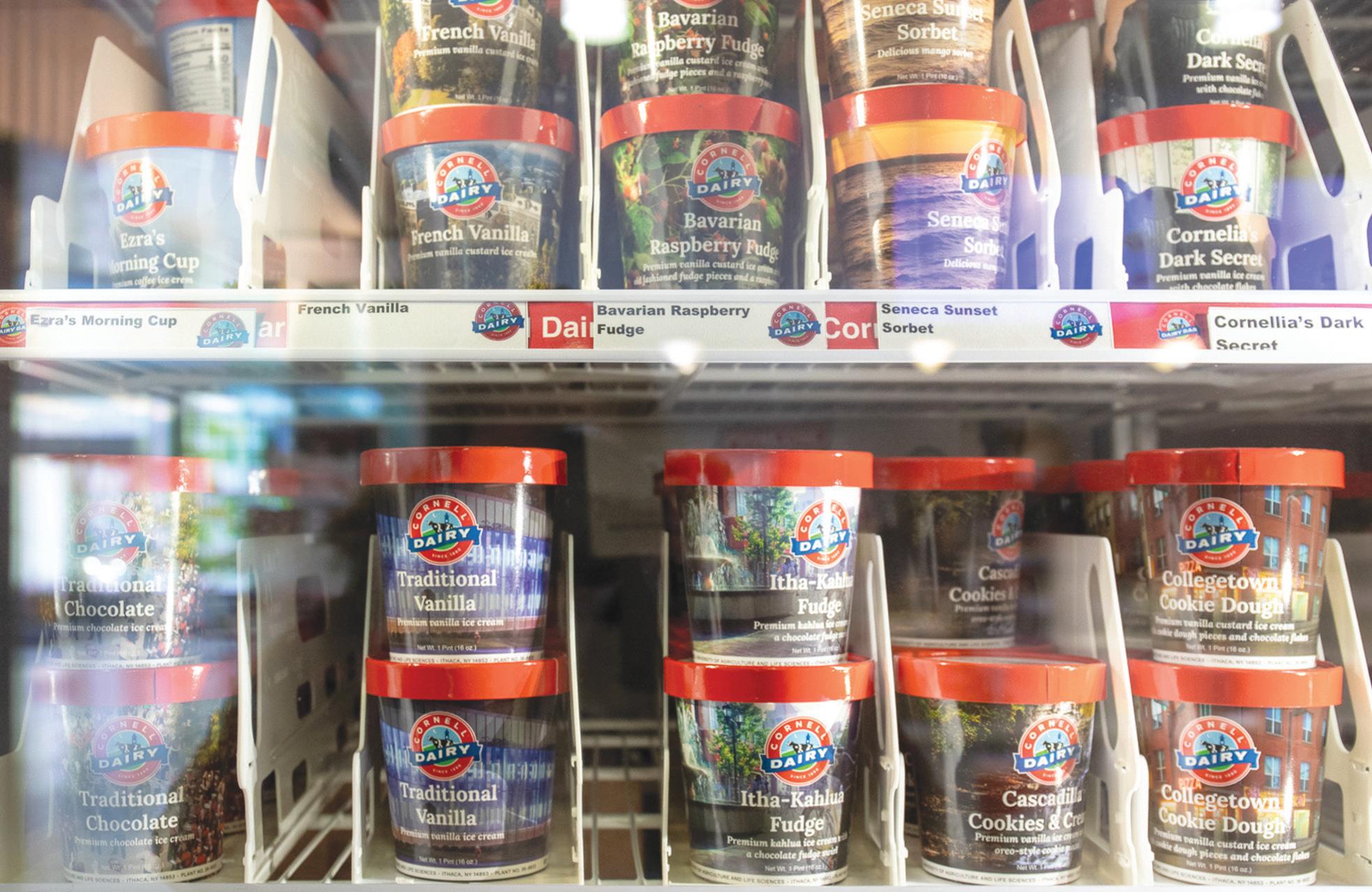

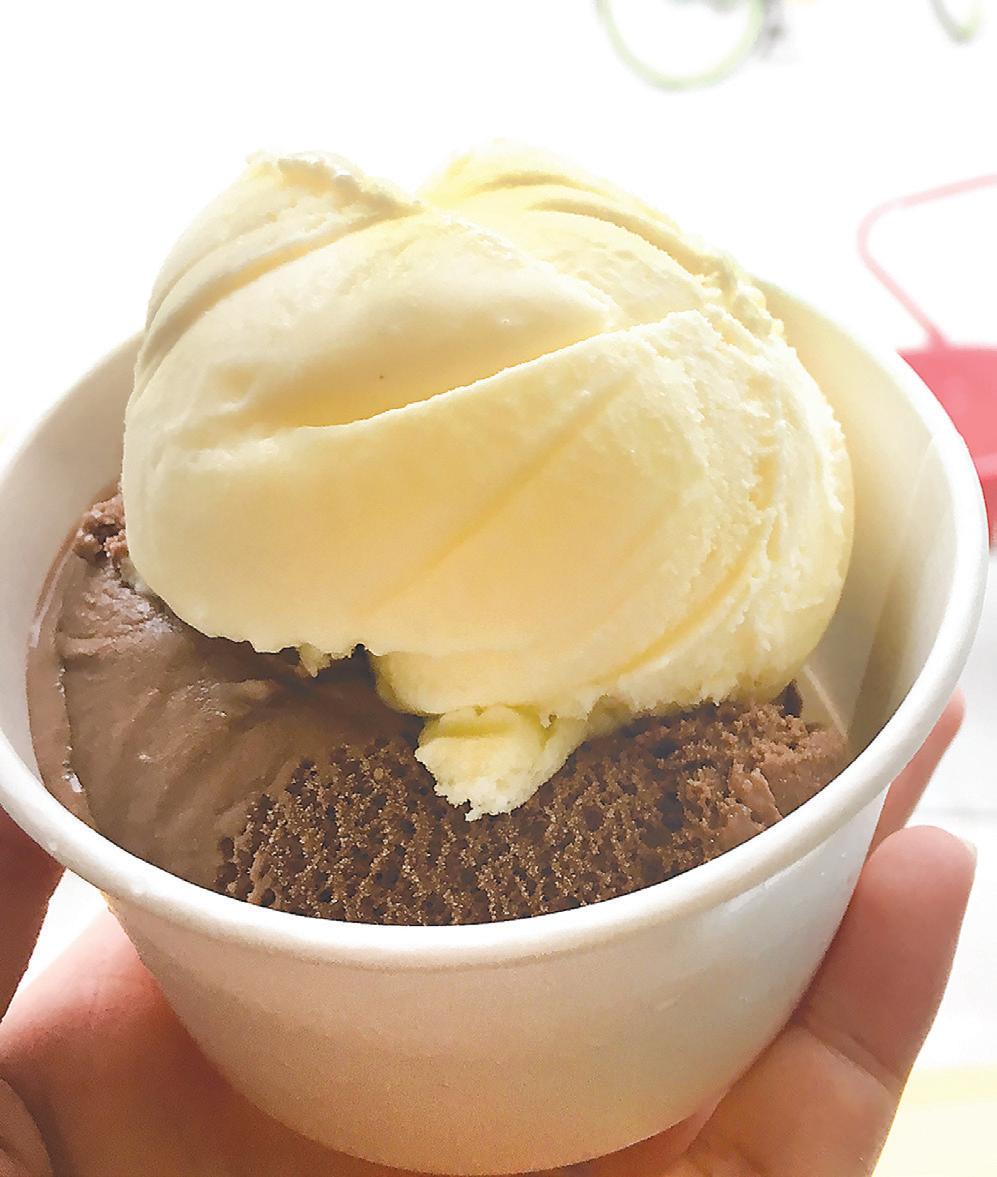
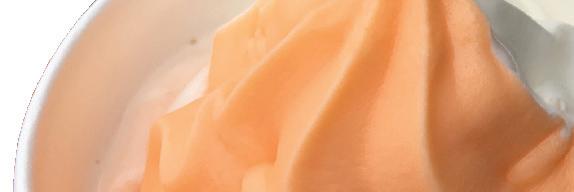
Of their 34+ flavors of ice cream (some of which are vegan), some of our favorites are bulldog crunch and green tea — good in scoops or blended into milkshakes. According to their menu on Ithaca To Go, bulldog crunch is a “praline-flavored ice cream with caramel swirl and chocolate-covered pecan candies.” This may sound strange, but bulldog crunch is absolutely mouth-watering, even though it’s in liquid form. The caramel and praline flavors are very strong, but the pecans and chocolate balance that creaminess and sweetness with their crunchiness and slight bitterness.
Green tea is much less sweet and made from “green tea powder blended with vanilla ice cream,” which was slightly disappointing because we were hoping it’d be made with real green tea leaves. However, making green tea ice cream with just leaves is quite difficult and can result in a barely detectable flavor. Purity’s use of powder means you get a more concentrated flavor and sometimes there are bits of powder that bunch up together, which could be likened to a swirl.
Besides ice cream, Purity offers frozen yogurt, pastries (cupcakes, pies, cookies and cakes), espresso and milkshakes. If you’re in the mood for more of a meal than a quick dessert, dig into one of Purity’s sundaes. From chocolate chip cookie to apple crisp, the sundaes are warm, gooey and perfectly comforting with scoops of your choice of ice cream and plenty of whipped cream.
Of our recommendations, Purity is also number one in the seating department. With abundant indoor and outdoor seating, Purity is extremely group-friendly, and its logo-covered decorations and booths give the space a relaxed, almost diner-like ambience.
If you can’t find the time to make the drive or take a walk to Purity, no worries — Collegetown Bagels (everyone calls it CTB) usually has six differently flavored tubs of Purity’s ice cream to choose from.
200 W. Seneca St.
118 W. Green St. (Press Bay Alley)
Another dessert staple of Ithaca’s food scene is Sweet Melissa’s (named after one of its founders), which has served ice cream cones since 2009. Sweet Melissa’s has at least 12 flavors of hard ice cream, served on rotation from day to day. These flavors range from Blondie Cookies and Cream to Lemon Ricotta and include a couple vegan options, too. We are obsessed with their sweet cream flavor — a sort of vanilla flavor that tastes more like custard, eggnog or perhaps even crème brûlée. It’s very subtle, but in a way that keeps your taste buds on the edge and leaves you wanting more! If you usually prefer hard ice cream with a lot of elements (like bulldog crunch from Purity), the sweet cream is just so refreshingly crisp that you will wish you had gotten another scoop.
Starting in summer 2021, Sweet Melissa’s began selling pints of its hard ice cream in local shops, from our very own Shortstop Deli next door to towns across New York State. So if you need a sweet fix outside of its seasonal hours, be sure to pick up a pint or two to
enjoy.
But its first and original location is our favorite; painted in cobalt blue and pastel orange, it’s hard to miss. This Seneca St. location offers both soft serve (of which there are eight flavors) and hard ice cream, as well as flurries, shakes, floats, sundaes and slushies. And if you follow its Instagram (@ithacaicecream), you’ll be tuned in to all its extra goodies, from chocolate chip cookies for ice cream sandwiches to Lucky Charms marshmallows for your flurries.
We’re fans of their classic twist (chocolate and vanilla) and their orange-vanilla twist (which combines orange sherbet with their famous vanilla ice cream). But don’t forget to get yours dipped — whether in chocolate or cotton candy flavor or sprinkles of the chocolate or rainbow variety. (Rumor has it that President Martha Pollack’s pick is vanilla dipped in peanut butter). Either way, it’s a fun goal to try all their other soft serve flavors during the fall semester, especially because The Sun’s office is located so closeby. Seating is entirely outdoor, but we recommend sitting on the stoop of Immaculate Conception Church or taking a walk through downtown to enjoy — just be careful of dripping cones as you eat.

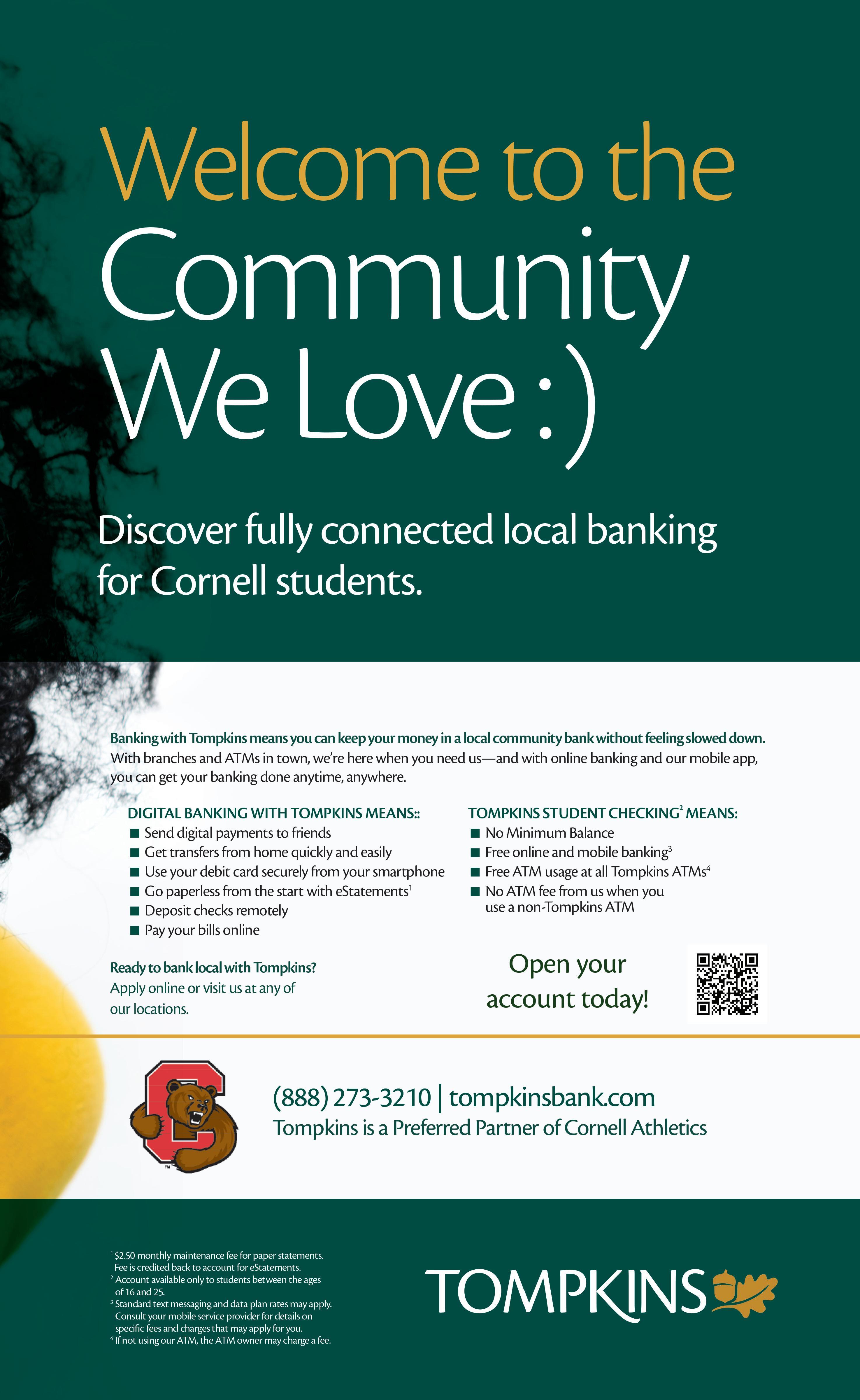

This story was originally published on Nov. 17, 2020.
In the 21st century, most Cornell-Dartmouth football games don’t make nation al headlines. But 80 years ago, in Hanover, New Hampshire, on Nov. 16, 1940, in what commentators called a stun ning display of sportsmanship, Cornell — then the top team in the country, rid ing a 19-game win ning streak — gave away an apparent 7-3 win after realizing its last-second touchdown was scored on fifth down.
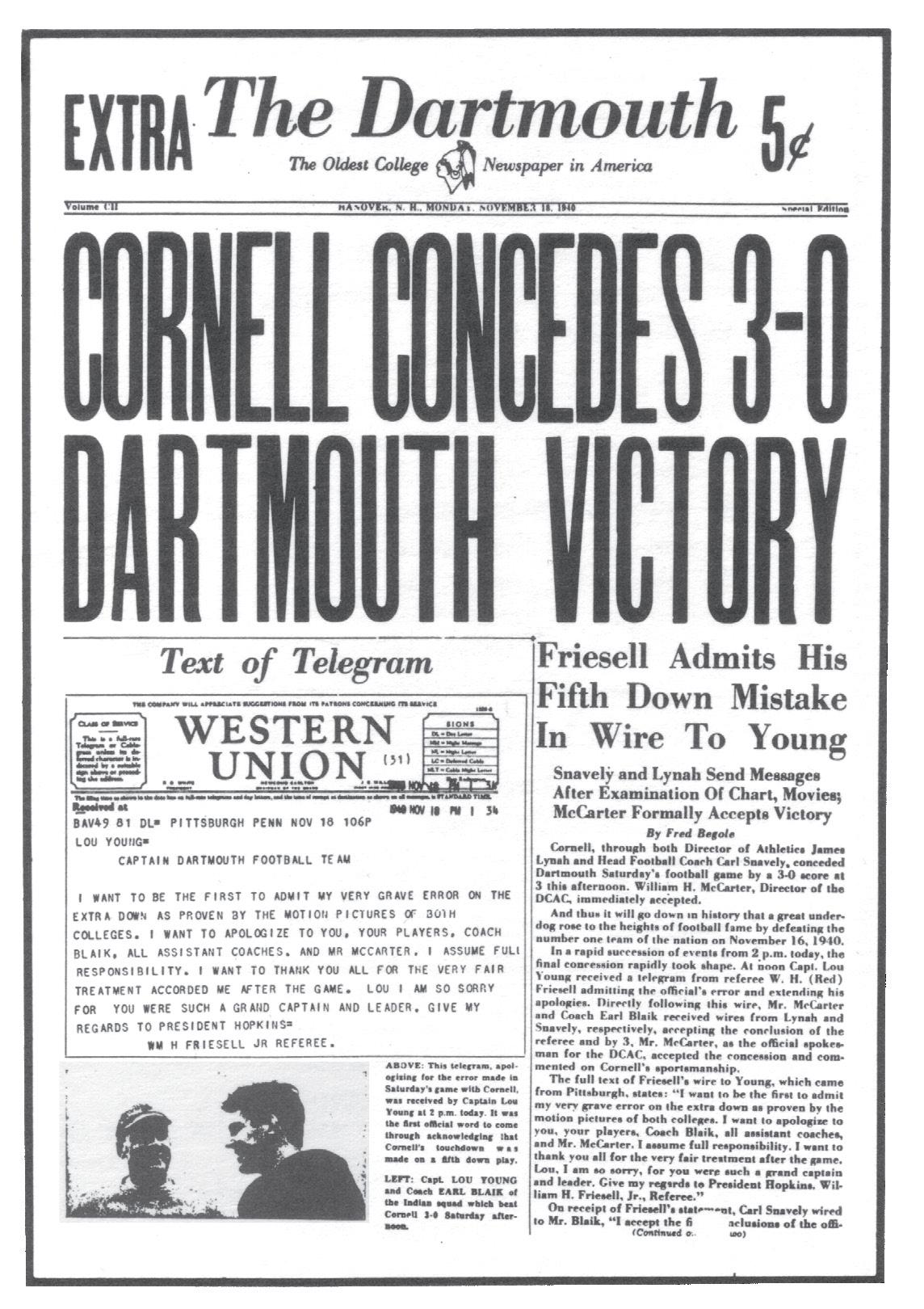
The Red entered the game against its longtime rival — then called the Indians — riding an 18-game winning streak dating back two seasons. Dartmouth broke a scoreless tie with a fourth-quar ter field goal, taking a 3-0 lead.
The Wikipedia page for the game reports that Cornell got the ball on the Dartmouth six-yard line with less than a minute to play. After short gains on first and second down, Cornell had the ball on the one-yard line. A run for no gain on third down followed by a delay of game penalty gave Cornell fourth down from around the fiveyard line.
left, Walter “Pop” Scholl ’41 threw an incomplete pass into the end zone. And that should’ve been it. But the
referee signalled fourth down, and Scholl found receiver William Murphy for a touchdown on the bonus down. Cornell won the game 7-3. Or so they thought. After reviewing film of the game on Sunday, coach Carl Snavely and Cornell officials realized the touchdown shouldn’t have happened. So they sent a telegram to Hanover offering to forfeit the game.
Dartmouth accepted, cementing the contest as a 3-0 win for the Edmund Ezra Day, then the president of Cornell, was a Dartmouth graduate. Lou Conti ’41, a guard on the 1940 team, told The Los Angeles Times in 2010 that Day said, “You can offer them the game, but they won’t accept
waiting for that telegram.’”
“Our coach and athletic director told us, ‘As the years go by, this will resonate as a fine example of sportsmanship’ — and they were 100 percent right,” Conti, then 91 years old, said in 2010. “But if I had been a grown person with some authority, I never would have offered to give the game away.”
“I can just remember my father telling me. He said, ‘Son, they will never remember that you guys were undefeated and that you had the greatest team in the nation.
But they’ll never, never forget that your college awarded that game back to Dartmouth.’”

At the time, an angry team and football-obsessed campus felt like the game had been unjustly stolen, even as praise for the act of sportsmanship came from around the country: A New York Herald Tribune editorial said “there seems again to be hope in the world.” Some players on the 1940 team insisted that Mort Landsberg ’41 got into the end zone on his third-down run that was marked just shy of the goal line. And while decades later they looked back fondly on the forfeit, at the time they couldn’t believe their university would give the win away.
“The pride is now. It wasn’t then,” said Frank Finneran ’41, a guard and defensive lineman on the 1940 team. “I can just remember my father telling me. He said, ‘Son, they will never remember that you guys were undefeated and that you had the greatest team in the nation. But they’ll never, never forget that your college awarded that
Down Game still stands alone in college football history: No other game has been decided off the clusion. A 1940 editorial in The Sun said “our honor and good name remain
Decades later | This play took place during the Cornell-Dartmouth football game on Nov. 10, 2018 — 72 years after the “FifthDown” football concession.
Frank Finneran ’41
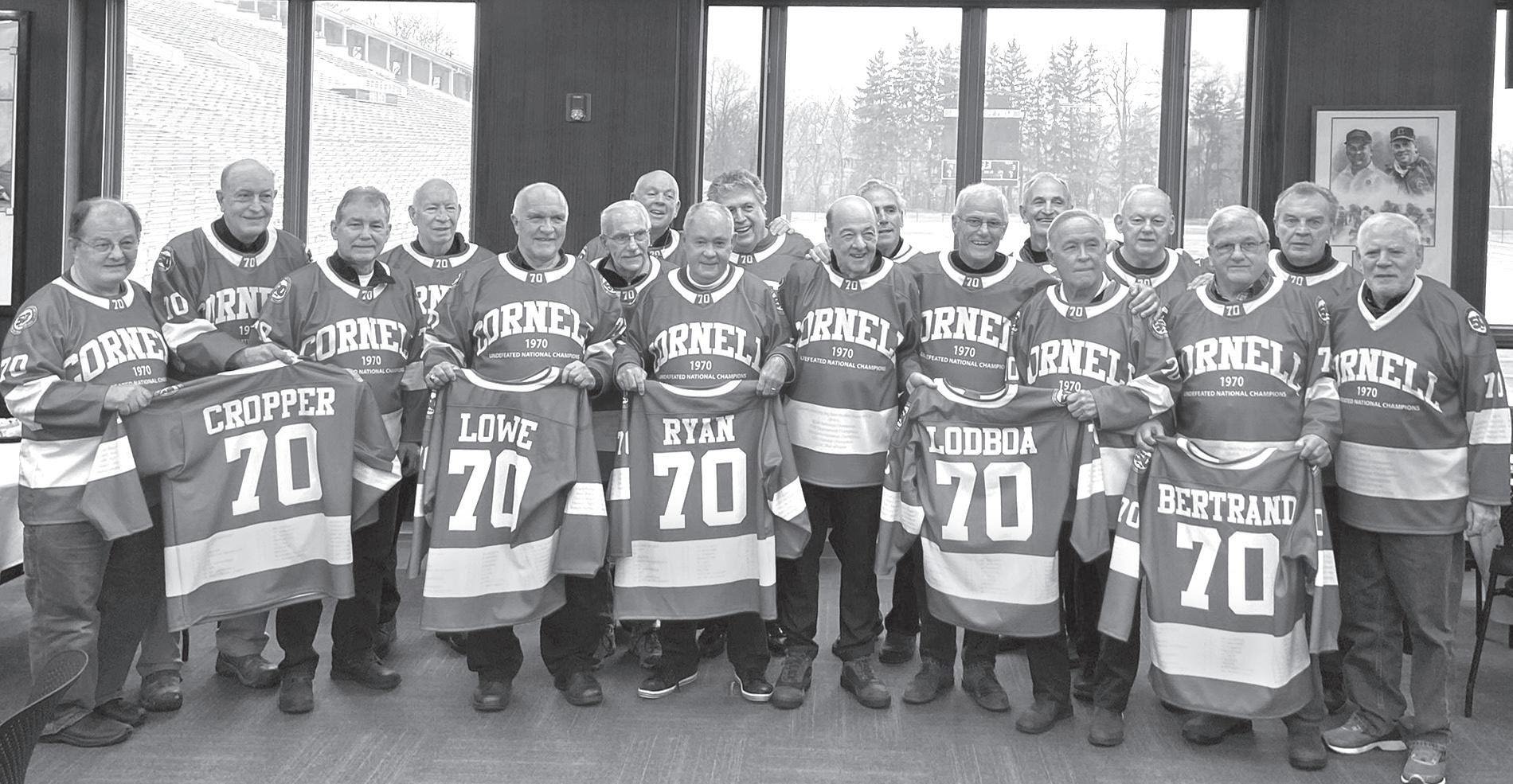 By LUKE PICHINI Former Sun Sports Editor
By LUKE PICHINI Former Sun Sports Editor
This story was originally published on March 4, 2021.
In one of the most outstanding efforts by an NCAA men’s hockey team, Cornell became the first — and so far, only — men’s hockey team to capture a national championship during the 1969-70 season without suffering a single loss or draw.
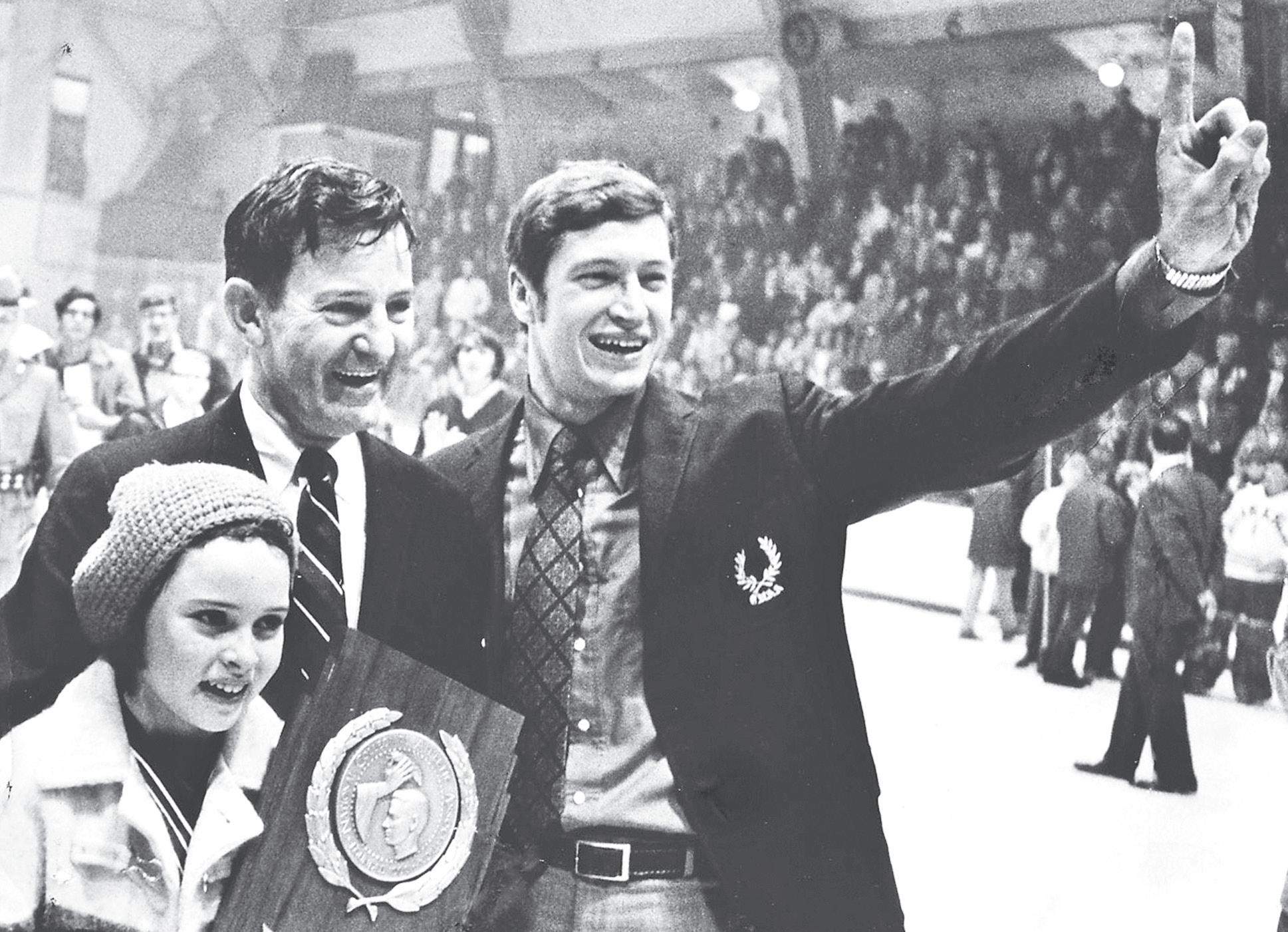
Cornell’s incredible 29-0-0 campaign began with an 8-2 stomping of Western Ontario, and from there, the Red continued to dominate, closing the first stretch of the season on a seven-game winning streak.
The lone scare came in a road matchup against Brown, when Cornell eked out a 5-4 overtime victory. Despite staring at a one-goal deficit in the third period, junior forward Brian McCutcheon came up with a power-play score to force an additional period of play.
The ensuing overtime period ended after a mere 34 seconds thanks to senior defenseman Dan Lodboa, who forced a Brown turnover and then found the back of the net. The Red’s victory in this contest became only one of five contests during the entire season that was decided by one goal.
During the holiday season, Cornell continued its hot streak, picking up victories over familiar foes, including Rensselaer, St. Lawrence, Boston University and Colgate. In that slate, the Red outscored its opponents, 25-6, including a 9-0 blowout of Rensselaer.
As the Red entered the conference portion of the regular season, it only maintained its dominance. Aside from a 2-1
victory at Toronto, Cornell rarely endured close games. While its home showdown against Dartmouth only ended in a 3-2 decision in favor of the Red and was certainly an exception, Cornell walloped that same opponent a week and a half later, shellacking the Green by a 14-0 margin.
In that 14-0 blowout, 17 different players tallied at least one point, with junior forward Bob Aitchison leading the way with five points, despite having entered the contest with only two goals on the season.
Playoff Challenges
Though Cornell encountered tough challenges from several of its opponents over the course of the season, the team entered the ECAC Championship on an offensive roll, having scored a whopping 41 goals during the final four games of the regular season.
That momentum carried over in the first round of the ECAC playoffs with a 6-1 beatdown of St. Lawrence. In the next round, though, the Red faced a much stiffer test in the form of the rival Crimson. In the span of just four minutes, Harvard’s attack came alive, beating junior netminder Brian Cropper three times to put the Crimson up 3-1, marking the first time all season the Red trailed by two goals.
Cornell buckled down, responding with four straight goals, but Harvard quickly scored two of its own to make it 5-5 in the final frame. But a penalty was called on the Crimson after its fifth goal, and sophomore forward Larry Fullan capitalized on the ensuing power play, giving the Red a 6-5 lead that it never relinquished.
Having claimed victory in the last three ECAC Championships,
Cornell sought a fourth title, but it would have to first defeat Clarkson to achieve that honor. Like its previous game against Harvard, the Red fought hard to grind out a victory. In a back-and-forth contest
Tournament against Wisconsin, the Red faced an initial deficit after the Badgers scored an early goal.
But in the final two frames, Cornell completely smothered the Badgers’ offense, only con-
national title game.
During the first two periods, the teams alternated leads before the Red pulled away in the last period. Buoyed by Lodboa’s three third-period goals, Cornell secured a 6-4 vic-
between two exceptional goalies, Cropper and Clarkson’s Bruce Bullock, it was ultimately Cropper and the Red who prevailed. With the game tied at two apiece, senior forward John Hughes fired a shot past Bullock in the waning seconds of the third period, clinching the Red’s fourth straight ECAC title.
Final Hurdles
With a perfect regular season under its belt, Cornell only had two more opponents in its way of achieving national glory. In the first contest of the NCAA
ceding four shots. Meanwhile, the Red finally broke through in the third period, notching two goals against Wisconsin goaltender Wayne Thomas to vault itself into the National Championship game.
Cornell’s final opponent was a familiar titan — Clarkson. The Golden Knights hoped to avenge their loss in the ECAC title game and spoil the Red’s perfect season in Lake Placid. In the early going, Clarkson appeared on track to do just that, scoring in the first 20 seconds of the
tory over Clarkson, clinching the program’s second national title while also etching its name in NCAA history by becoming the only undefeated national champion.
Unmatched
In the years since, Cornell has retained a strong program, especially under head coach Mike Schafer ’86. Still, it remains fairly unlikely that the Red — let alone any other NCAA men’s hockey squad — will be able to achieve the same heights of the 1969-70 Cornell team.
This article was originally published May 8. No. 41 Cornell men’s tennis (18-7, 4-3 Ivy) headed down south to Durham, North Carolina last weekend, May 6 and May 7, for the first two rounds of the NCAA tournament. After a hard fought win against No. 23 Auburn (17-12, 5-7 SEC), who boast three nationally ranked singles players and a top-20 doubles team, the Red fell to No. 12 Duke (22-6, 11-1 ACC), ending an up-anddown season on a relative high.
Against Auburn, Cornell started out well in doubles. After a tough loss at first doubles, where the No. 17 team of Finn Murgett and Raul Dobai of Auburn outclassed sophomores Nathan Mao and Adit Sinha, Cornell struck back at the No. 2 spot. Freshman Petar Teodorovic and junior Samuel Paquette looked excellent, winning 6-1 and evening the score. This left it up to No. 3 doubles, where, without senior Vladislav Melnic for the match, Cornell debuted a relatively new team, sophomore Radu Papoe and freshman Aman Sharma.
The match was a battle, with both teams leading at points before the score became tied at 4-4. The Red picked up a clutch break, though, and rode out the match, winning 6-4. Throughout the contest, it was difficult to tell that Sharma and Papoe haven’t played together often. Sharma excelled at the net, rarely making errors and placing his volleys precisely, while Papoe’s shotmaking from the baseline got the duo out of tough situations.
Holding a 1-0 lead, the match turned to singles, where Cornell faced what was almost certainly their biggest challenge of the year. Auburn’s lineup showed its strength early, as Sharma, Sinha and Paquette fell in straight sets, putting Cornell one point away from exiting the tournament in the first round.
Mao immediately struck back at fourth singles, taking his match 7-5 6-3. Mao, who has been a consistent performer all season, stuck to his normal gameplan, hitting his groundstrokes deep and coming to the net often, sometimes even on his second serve. Mao’s opponent, Jan Galka, never looked comfortable dealing with his pressure.
Mao’s win left the match down to Papoe and Teodorovic, who both played long, difficult matches. Papoe, ranked No. 88 in singles, came out firing, leading the first set 5-2 before No. 51 Tyler Stice took the set to a tiebreak, which Papoe won. After a second set loss, Papoe once again proved his quality, winning the third set 6-4 and tying the match. Teodorovic would have to battle in the first but took the set 7-5, before No. 119 Murgett evened the score. Up 5-4 and with the potentially deciding game tied 40-all, Teodorovic served to Murgett’s body, taking his opponent by surprise and giving Cornell only their second ever NCAA tournament win.
Against Duke, the Big Red faced an even tougher task, and it wasn’t their day. At No. 12, Duke was the highest ranked opponent Cornell faced all season, and their lineup featured many highly ranked competitors, including the highly touted Garrett Johns, who is inside the top 25 in singles and doubles.
Doubles was a mixed bag for Cornell, as after a tough loss at No. 1, Teodorovic and Paquette struck back with a 6-4 win at second
doubles. Despite Melnic being available, Cornell stuck with Sharma and Papoe at No.3, and after a hard fought set, the new duo fell 7-5, giving Duke the doubles point.
In singles it didn’t start out much better, as in his return to the lineup, Melnic had to retire due to injury in the second set, bringing Cornell down 2-0. It was a disappointing end to a great Cornell career for Melnic. Mao soon fell in straight sets, extending Duke’s lead, before Teodorovic capped off an excellent first tournament for the Red, battling back from a first set loss to secure his fourth tournament win in four chances.
After Paquette lost a tough three setter, however, Duke took the match and ended Cornell’s tournament run. This mathematical loss ended Sinha and Papoe’s matches early, despite both having just won second set tiebreakers. Papoe’s match was particularly impressive, as it came against the excellent Johns.
It was a tough end to what has been an inconsistent season for Cornell. However, given the great performances Cornell has gotten all year from its underclassmen, the future looks bright for the Red.
By GRAYSON RUHL Sun Sports EditorThis article was originally published Nov. 19.
Football entered this Saturday, Nov. 19 with an important goal in mind: To break its 17-year stretch without a winning season. Facing off against Columbia in the Empire State Bowl, the team fell short of breaking the drought, losing heavily against the Lions, 45-22.
The Red (5-5, 2-5 Ivy) has employed a runbased, ball control style of football throughout the year. However, with its top three running backs sidelined, its identity was put to the test. Sophomores Eddie Tillman and Robert Tucker III, along with freshman Gannon Carothers, are all currently injured, leading the running responsibilities to be shared by freshman AJ Holmes and junior Drew Powell.
Columbia (6-4, 3-4 Ivy) was coming off of an exciting overtime win against Brown. The Lions was seeking its fourth winning season in the last five years.
Cornell got off to a slow start, going threeand-out on its first possession. The same could not be said for Columbia, with its offense churning off the bat.
The Lions charged down the field, with
quarterback Caden Bell hitting wide receiver Marcus Libman for a 53-yard strike over the middle on a 3rd and 9. Putting Columbia just outside the red zone, the team was able to put together a series of positive rushes to push the ball into the end zone.
Looking to respond, a false start against the Red put the team behind the chains. Faced with a third-and-long situation, sophomore quarterback Jameson Wang overthrew junior wide receiver Nicholas Laboy, and it was picked off by the Columbia defense. The ensuing runback gave the Lions an instant redzone opportunity.
With a chance to create an early cushion, Columbia took over on offense. Similarly to last week, however, it was the Red’s defense picking up its offense. Two plays into the drive, sophomore safety Trey Harris forced a fumble, and senior cornerback Paul Lewis III fell on it to get Cornell the ball right back.
The Red attempted to capitalize on the turnover, putting together a drive into Columbia territory. Eventually faced with a 4th and 1 situation, a sneak by Wang was stuffed by the Lions’ defensive line, and Cornell turned it over on downs.
To continue reading this article, please visit www.cornellsun.com.

This article was originally published on March 25. MANCHESTER, N.H. – Men’s hockey fell to Boston University, 2-1, on Saturday, ending its NCAA Tournament run in the quarterfinals.
With the loss, Cornell ended its season one game short of the Frozen Four. The team has lost six regional finals since its last Frozen Four appearance in 2003.
“As a coach, I’ve only been in the Frozen Four once and it stings not to get there,” said head coach Mike Schafer ’86.
The Terriers scored the first goal, and Cornell never generated enough pressure to mount a comeback. The Red only fired 14 shots, many of which B.U. goaltender Drew Commesso tracked without issue.
In a tight game, the Red was not able to overcome a few sloppy plays against a B.U. team with fluid-skating forwards and rock-solid defenders.
Cornell got off to a hot start in its regional semifinal on Thursday against Denver, but was more tentative on Saturday. The Terriers controlled the pace of the first few minutes and challenged sophomore goaltender Ian Shane early.

Notably, BU’s Quinn Hutson collected a Jack O’Leary turnover and got a partial breakaway before O’Leary hustled back to break it up. Shane also came up with a couple of saves on the ensuing offensive zone possession by the Terriers.
The Red started to apply more pressure midway through the period. A long shift resulted in a few good looks at the net, but Commesso made a series of saves to keep the game scoreless.
The second half of the period featured the game’s first special teams action. Each team took and killed a penalty. First, freshman forward Winter Wallace was called for tripping with just over four minutes left. The Red extended its consecutive kill streak to 18 before Luke Tuch went off for roughing. Cornell came up empty on its first power play.

Unlike in its win against Denver two days ago, the Red was unable to get on the board quickly, and thus could not dictate play as it would with a lead. The teams went to their locker rooms after a scoreless first period.
“In hockey, it gets to that point in time, you know how important that first goal is,” Schafer said. “We scored against Denver first and we were able to do some things differently.”
The Terriers’ pressure and fast-paced play finally paid off not long into the second frame, when Wilmer Skoog received a nifty pass from the far corner and one-timed it
turnover at Cornell’s offensive blue line led to a breakaway by B.U.’s Quinn Hutson, who fired a shot that rang off the post.
The Red entered the second intermission down 1-0.
“You go in the third period, you got to try and stay the course,” Schafer said.
Cornell was much better at defending a lead than chasing a deficit this season. The Red went 19-0 when leading after two periods but entered Saturday 2-10-2 in games where it was tied or trailing heading into the third period. Before B.U.’s second period goal, the Red had not played from behind since Feb. 18.
“Cornell is a very good team when they have a lead, so I think it was important for us tonight to get that first goal and see if they will press a little bit,” said B.U. head coach Jay Pandolfo.
past Shane. The pass was the result of a Cornell turnover and blown coverage on Skoog.
Cornell’s penalty killers were put to the test once again when senior forward Zach Tupker went off for a crosscheck in the offensive zone. Despite a few quality chances from the Terrier power play unit, Shane and the Red penalty kill successfully fended off its 19th straight kill.
Once again, the Terriers followed their power play with a penalty of their own, this time for having too-many-men on the ice. The Red generated more chances on its second power play of the game, but could not get the puck past Commesso. The majority of the Red’s shots were taken from the perimeter, allowing Commesso to see them all the way.
“We made a mistake, they capitalized on it,” Schafer said. “We had a good power play to try and make it 1-1.”
Commesso got a lucky break when a puck deflected off a stick in the lane and went past his helmet before hitting the crossbar and bouncing the other direction.
“You look back and wish you could’ve done things differently throughout the game, like bury that chance or not hit the post,” said senior defenseman Travis Mitchell.
Later in the period, puck luck was in the Red’s favor – a
In 1940, in what is now remembered as a stunning display of sportsmanship, Cornell — then the top team in the country, riding a 19-game winning streak — gave away an apparent 7-3 win against Dartmouth after realizing its last-second touchdown was scored on fifth down.
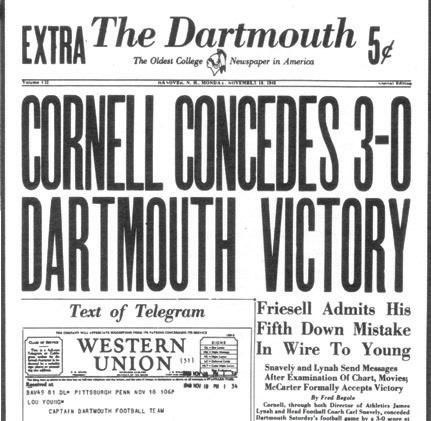
page 25
It took nearly half the period for either team to get a quality look in the third, as both forechecks prevented zone time on either end. However, it was the Terriers that eventually broke through when Ethan Philipps buried his own rebound to give B.U. a 2-0 lead.
Cornell received a third power play opportunity not long after but was once again blanked and unable to generate much meaningful offense. The Red went scoreless on six power plays across its two NCAA Tournament games.
From there, Cornell’s offense was shut down by the Terrier defense. The Red had difficulty getting passes through Terrier sticks and failed to generate chances in front of the net. Cornell only put three shots on target in the third period. The Terriers blocked 21 shots during the game.
Shane was pulled with just over two and a half minutes remaining in the game, giving the Red one final opportunity to eat at B.U.’s lead. Cornell was able to establish some zone time, but the Terriers complicated things by creating turnovers and firing attempts toward the empty net.
To continue reading this article, please visit www.cornellsun. com.
Student Guide pages 24-25
No Losses, No Draws page 26
During the 1969-70 season, Cornell became the first — and so far, only — men’s hockey team to capture a national championship without suffering a single loss or draw.
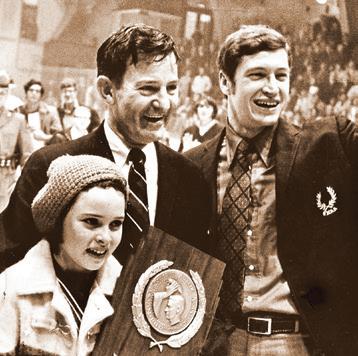
Cornell fans really get into the Red spirit and we have the photos to prove it.